


















































































































































































































































It’s been a busy few weeks on the news front! With the Intermot show in Cologne kicking off the big bike shows, and EICMA in Milan following in just a few weeks’ time, we’re soon going to know all the key stuff about the bikes that are going to make it to market for 2023 (and beyond).
So far we’ve had our heads turned by Honda’s new 90bhp Hornet, Ducati's fully-loaded Multistrada V4 Rally and Suzuki’s off-road ready V-Strom 1050DE (about time...). But really, that’s just the tip of the iceberg. There’s going to be a whole load more good stuff to check out in the coming weeks (and months), and we’ve already got our eyes set on Motorcycle Live for the chance to poke, prod and clamber over the latest metal in the flesh. Will you be there, too? What are you most excited about seeing?
Speaking of which, we've managed to blag TEN pairs of tickets for the UK’s biggest bike show (which takes place at the NEC from November 19-27) – and we’re offering you lucky lot the chance to win them. If you’re interested, flick through to page 8 and find out more.
There’s actually a load of good stuff up for grabs in this issue. In addition to the usual competition page (this month, you can win a Duchinni helmet), we've also got a chance for you to win a set of Held’s Twin II four-season gloves (worth a whopping £190). To be in with a shot we’re asking for you to fill out an online survey and tell us what you like and what you don’t about MoreBikes. It's really valuable for us to get feedback from you, so if you’ve got five minutes to spare and you fancy shaping the future of this very paper, simply head to the MoreBikes website and click on the survey (or check out page 52 for more information).
In the meantime, ride safe...




The German firm has revealed its latest generation S1000RR superbike –and with improvements to the engine, suspension, chassis, aerodynamics, design and on-board technology, could this be the best one yet?

BMW’s flagship sportbike has gone from strength to strength since it was first revealed way back in 2009. It gets better every time and as such, it’s found plenty of love among serious riders with a penchant for speed. But it’s been three years since the last one was released, so it’s about time for some proper updates to bring the latest Beemer bang up-to-date.
First things first. The engine. The S1000RR actually comes kitted out with the same (or very similar) 4-cylinder in-line engine as the outgoing model. That said, BMW’s managed to up the peak power output slightly to 210hp at 13,750rpm (which is 3hp more than before), while maximum torque of 113Nm is available at 11,000rpm. BMW reckons it’s made the engine more usable across a broader range than before.
The RR’s chassis is still centred around an aluminium bridge frame which integrates the engine as a
support. But there’ve been some key changes to help give it more flex, including giving the main frame several openings in the side. BMW’s also chosen to flatten the steering head angle (just a touch) and reduce the offset of the triple clamps (by 3mm). It might not sound like much, but it’s all the small stuff that makes a difference.
It gets some M RR inspired winglets, which’ll help offer aerodynamic downforce to ensure the front end’s making the best possible contact with the road (particularly important during heavy acceleration). That means the latest generation bike’s going to be less likely to experience front wheel lift, but it also means you can brake later and that you’ll experience improved stability in the turns. And the wings look pretty cool. too… There’ve been a few more styling tweaks to the front end and there’s also a new sportier-looking rear end, in addition to three new colour schemes to choose from (Blackstorm metallic, Style Passion in Racingred non-metallic and the racing-oriented Lightwhite non-metallic/BMW M). Diving down into the technology of
the new S1000RR, there’s a new Slide Control function to the Dynamic Traction Control (DTC) system. It’s a clever bit of kit which allows riders to select from two preset drift settings. The traction control system allows slip at the rear wheel when the rider’s accelerating out of a bend – which then means you’ll get some rear wheel drift. The bonus of the technology is that you can set the steering angle
value at which you want traction control to intervene, reduce slip and stabilise the bike. Clever stuff The system works in a similar way for the new Brake Slide Assist, too – allowing riders to slide into corners.

Prices start at £17,150 for the standard model and increase to £18,610 for the Sport. If you want to find out even more about the S1000RR, check out the BMW website.


Do you fancy owning one of the world’s very few limited-run supercharged production bikes?
Now’s your chance, because Kawasaki has just opened the pre-order book for the 2023 version of its rare and raucous H2R.
With power and torque rivalling top-flight MotoGP machines, the Kawasaki H2R (and to a lesser extent the marginally less powerful ‘standard’ H2) are truly special bikes that stand apart from the current crop of motorcycles available on the market.

It’s been largely unchanged since its introduction a few years ago and features a 998cc inline four-cylinder
engine; a proprietary supercharger; a lightweight trellis frame; carbon fibre aero technology; fully adjustable highperformance racing suspension; and a rigid single-sided swingarm. More specifically, it comes kitted out with the Kawasaki Launch Control Mode (KLCM); superbike-specification Brembo Stylema monobloc callipers; an Öhlins rear shock; highly durable self-healing paint; and, of course, a whole host of electronic goodies to help keep it in check.
As you’d expect they’re not cheap, and if you like the idea of running a 300hp, 240mph monster, you’ll need a whopping £50,000 to play with (and you can’t even ride the bike on the
road). But if you are interested, you’ll need to act fast because the window for placing factory orders
closes on November 11. Get in touch with your closest official Kawasaki dealer to find out more.

There’s little doubt that Ducati’s 170bhp Multistrada V4 is one of the biggest and best adventure bikes on the market. But up until now it’s been missing a little bit of off-road prowess. Thankfully, the Italian factory’s just revealed a new version that’s ready for some dirt-based shenanigans.
The arrival of the newest Multistrada Rally doesn’t come as a big surprise. Ducati’s got form of rolling out its ‘standard’ roadgoing variant, before following it up a year later with a seriously capable off-road ready machine. That’s exactly what’s happened here – and as you’d expect, the Multistrada V4 Rally looks like it’s going to be a good ’un.
Just like the stock V4, it comes kitted out with top-of-the-line semi-active Skyhook suspension from Showa – although it’s up 30mm to a massive 200mm. The Skyhook system is seriously impressive on the standard machine, but the Rally actually gets some new ‘selflevelling’ hardware, which Ducati reckons will help keep the bike on an even keel when things get properly rough. Sounds good to us…
The electronic trickery doesn’t end there. The new bike gets an additional riding mode that’s been specifically designed for
‘extreme’ off-road riding. The dedicated mode uses a different throttle map to the three road riding modes and limits power to a more manageable 114hp. It also adjusts the traction control settings so you’ll get less interference, in addition to turning off the ABS at the rear wheel, turning the wheelie control off and supressing the cornering functionality and rear lift detection. Considering Ducati’s form with rider aids, it’ll likely be pretty spot on.
Another nice touch is the addition of a new system which follows in the footsteps of Harley-Davidson’s Pan America. It’ll adjust the preload settings when you turn it on, to help make it easier to muscle off (or on) the stand – and to climb on and off when you’re setting off or coming to a halt.
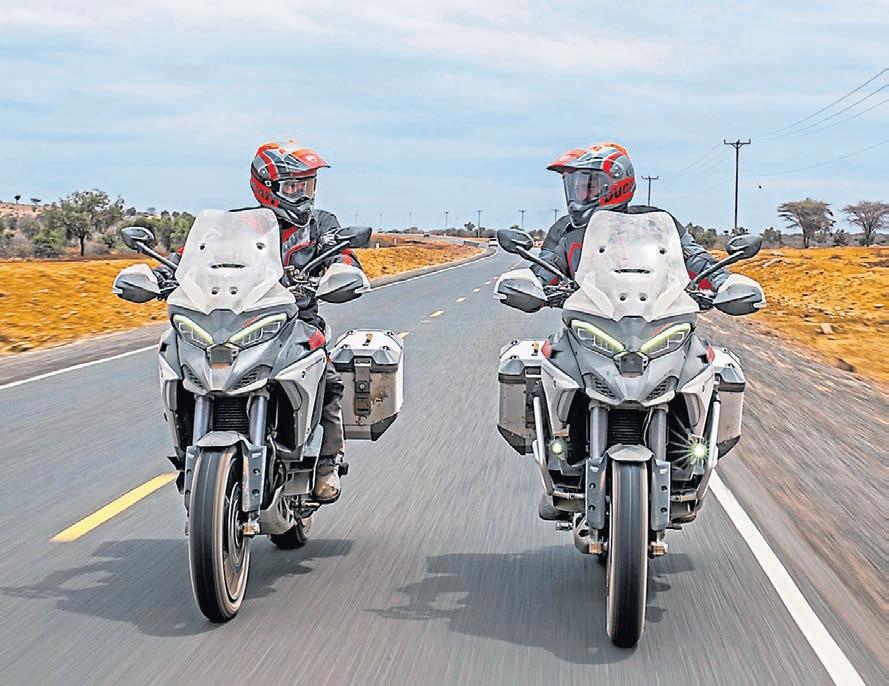
In addition to all the usual off road related goodies, it gets a set of lightweight spoked wheels as standard and a massive 30-litre fuel tank (which is a whole eight litres bigger than the standard machine). Of course, the Multi’s a thirsty beast, but you’ll be able to turn in around 250 miles if you’re not pressing on too hard. To help improve efficiency (even if it’s only nominal), Ducati’s actually adjusted the cylinders of the V4 engine, making it so that the rear bank is able to deactivate while
the bike is moving. The previous model would do it when you came to a standstill,but now it’ll do it when you’re riding gently (pottering
through town or stuck behind traffic). Every little helps, right? No news just yet on pricing, but there’s little doubt it’s going to be
cheap. Historically the Rally’s always been the priciest model and we’re expecting it to be no different for next year.











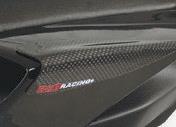








Honda’s unveiled the hotly anticipated 2023 version of its much-loved Hornet at the Intermot Show in Cologne.
It feels like we’ve been talking about the potential return of one of Honda’s best-loved bikes for years – and with the factory releasing a whole host of design drawings early in the year, there’s been plenty of anticipation building about what exactly the finished bike would be like. And the wait’s finally over, because the Japanese firm has just shared all the need-to-know information about its CB750 Hornet.

The big news is that it’s powered by a newly designed lightweight 755cc parallel motor. It’s a bit of a departure from the old inline-four set up, but Honda reckons that the much-loved top-end Hornet ‘sting’ is still there. With peak power of 90bhp arriving at 9500rpm, we’re sure it’ll be plenty of fun chasing those revs to get the most out of the engine. Its 55lb-ft of peak torque is available at a slightly lower 7250pm, which should help give the Hornet enough lower and mid-range grunt to be usable and fun even if you’re not pressing on. There’s more clever stuff to try and replicate the Hornets of old, with its 270° crank and uneven firing order working together to create (what Honda’s calling…) a ‘V-twinlike’ pulse feeling.


The frame of the Hornet is a brandnew steel-diamond number, which tips the scales at an impressively light 16.6kg. Suspension comes in the form of a set of Showa 41mm Separate Function Fork Big Piston (SFF-BPTM) USD forks up front, while the rear shock (with adjustable pre-load) works in partnership with a Pro-Link set up and newly developed steel swingarm.



There’s a 5-inch TFT colour display (which offers connectivity to the Honda Smartphone Voice Control system for both Android and IOS devices); LED lighting across the board; auto-cancelling indicators; and Honda’s flashing Emergency Stop System. There’re also four riding modes to choose from, with three of them offering pre-set combinations




of Engine Power, Engine Brake and Honda Selectable Torque Control (with integrated Wheelie Control). The fourth ‘User’ mode allows you to dial in settings as they see fit.







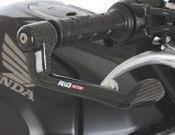











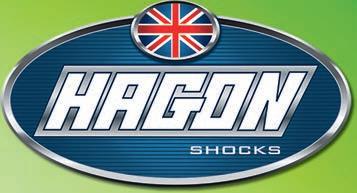








It’s available in either Pearl Glare White and Graphite Black (which feature a Metallic Red Flame frame and anodised Red forks), Matte Iridium Gray Metallic and Mat Goldfinch Yellow – and there’s a whole host of official accessories available for the CB750 Hornet, too, including three unique packs to make it easy to tweak the bike to best suit.
It was always going to be exciting to see what Honda came up with for the latest incarnation of its Hornet – and looking at the facts, figures and the actual style of the thing
(never mind the fact that it’s priced at a super-competitive £6,999), it certainly seems like the factory has delivered. Although there’s been no specific confirmation on availability, Honda UK has said that we can expect bikes to land in dealers during the early part of 2023 (though that’s not exactly set in stone as a result of ongoing supply issues). Before that, we’ve been offered the chance to put one through its paces and we’ll be bringing you our first thoughts on the bike here on MoreBikes.



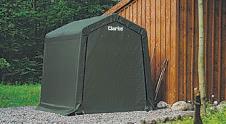












Here’s what YOU need to know.

Replacing the long-standing XT as the flagship adventure bike in the Japanese factory’s range, the V-Strom 1050DE gets a load of additional off-road focused kit and some seriously swanky tech to bring it bang-up-to-date for 2023.
Suzuki has revealed a new, more off-road ready version of its venerable V-Strom adventure bike.



The big news is the addition of a 21-inch front wheel, which replaces the previous generation’s 19-inch number. There are spoked wheels as standard, and they come neatly wrapped in a set of Dunlop’s TRAILMAX MIXTOUR tyres. That’s a good start, right?
The engine’s the same tried and tested 1050cc powerplant from the previous generation V-Strom 1050, but Suzuki has made a few small but important tweaks to help make it even better. There’re also updates to the transmission, including taller first and sixth gears. Also, the DE actually gets a stronger drive chain with sturdier links and larger diameter pins to help it take a bit more of a beating in the dirt
There’s also new longer travel suspension in the form of a set of fully-adjustable front forks and rear shock from KYB (which offer increased rake and trail, in addition to greater ground clearance of 190mm). It’s also 40mm longer than the standard V-Strom 1050, as a result of a new aluminium swingarm,
while some tapered aluminium handlebars offer an additional 40mm of width and should help to improve ergonomics when you’re stood up on the pegs.
In addition to the new subframe, the twin-spar aluminium frame has been updated for 2023. We won’t get into all the specifics about the aluminium castings with extruded aluminium sections because all you need to know is that it’s lighter and stronger.
There’s a new fixed seat; a slightly smaller screen; a more rugged front mudguard; engine bars as standard; a sturdy-looking aluminium sump guard; and there’re even some wider steel footpegs which have been designed with off-road riders (and their boots) in mind.
More good stuff comes in the form of a centre stand and hand guards, and LED light all round, while a USB power socket next to the screen makes it easy to charge your phone or satnav on the move (and there’s actually an additional 12V socket located under the seat).
As you’d expect, there’s also a pretty sophisticated electronics package to play with… which is almost
exclusively operated (bar the cruise control) using the full-colour TFT dash and switchgear on the lefthand switchgear. More specifically, the DE comes kitted out with the Suzuki Intelligent Ride System (SIRS), which includes a six-axis IMU (which manages the lean angle-sensitive ABS, the ride-by-wire throttle and the linked brakes). There’s cruise control, low RPM assist and even a hill hold control, too. Using the Suzuki Drive Mode Selector, you can flick through four riding modes. There’re
three for the road and an additional G (gravel) mode which has been set up specifically for off-road use. There’s also the option to turn off the rearwheel ABS entirely. Oh, and there’s also a bi-directional quickshifter as standard.
Both the V-Strom 1050DE and V-Strom 1050 use the proven 90° V-twin engine, which remains a perfect fit, with a design that provides perfect primary balance, with each of the two cylinders cancelling out the vibration of the other. This
eliminates the need for any balancer shafts, preventing the mechanical loss associated with them, and this connects to improving thermal efficiency for higher power output.
The layout of the V-twin engine also allows for a slimmer chassis design with a lower centre of gravity, and this contributes to more agile handling and greater manoeuvrability.
Taking inspiration from Suzuki’s iconic DR-Z800 racer, the DE comes in either a sharp yellow and white paint job with gold rims, or a typical blue and white Suzuki colour scheme with blue rims. And there’s also a mean looking all-black version. As you’d expect, there’s a whole host of additional accessories for the bike, including aluminium luggage, heated grips, lower seat options.
It’s expected to be available in Suzuki dealerships in early 2023, but unfortunately there’s been no official news on UK pricing just yet. We’ll keep our ear to the ground and let you know when we find out more.
The Austrian factory has just revealed the latest version of its much-loved middleweight adventure bike – and for 2023, there’s a whole host of additional goodies.
We love the KTM 890 Adventure here at MoreBikes. It’s a prime example of the raucous but still utterly usable bikes that’ve helped cement the Austrian factory’s reputation as one of the best in the game in recent years. And one of the best things is that KTM’s always pushing things further and finding ways to improve.
That’s exactly what’s happened for 2023, with the big reveal of its KTM




890 ADVENTURE R. Taking the lead from the Dakar-ready 450 RALLY, the new bike gets fully adjustable WP XPLOR forks and a WP XPLOR PDS rear shock, a new fairing, a new fuel tank, and a new cowling. There’s also a new, lower screen, a higher front mudguard and a new engine protector, too.
The technology’s also been improved, with a new 5” TFT display (equipped with USB-C connecters), which comes with an improved turnby-turn plus navigation system. That’s not all, as KTM’s upgraded the bike’s electronics package, too, fitting the latest generation of ABS control unit (which makes use of a 6D sensor to
inform the CMU on the angle, pitch, speed and general behaviour of the bike) to ensure that there’s the correct amount of braking force for any given situation. There’s also OFFROAD ABS as standard in the OFFROAD riding mode (and you can add the optional RALLY MODE, too).
There’re new colours for the seat, Mitas ENDURO TRAIL+ tyres as standard, and some new graphics to choose from. No news just yet on pricing or availability, but chances are it won’t be long before we find out everything we need to know.
There’s a load of additional technological trickery on the latest KTM 890 Adventure R and to access some of it you’ll have to outlay more cash on top of the cost of the standard bike. To help you work out whether or not you need to, KTM’s decided to launch a new Demo Mode which unlocks all of the optional tech extras for the first 1500km. That’s a pretty good idea, right?
It’s been a four-year wait, but Vespa’s finally released its newest ran of GTS scooters.

As you’d expect, the Italian factory is sticking to its tried and tested successful formula of building stylish scooters that go almost as good as they look. And while on the surface it might not look like ther amount to get excited a there is.
There’s the usual array or models and variants to choose from – with the ‘standard’ Vespa GTS, GTS Super, the GTS SuperSport, and the GTS SuperTech all available with either a 125cc I-GET single-cylinder motor, or a 300cc HPE (High Performance Engine). However, the big news is that the latest generation of GTS machines get new suspension and brakes. It’s not exactly revolutionary, but the traditional single-arm system has been redesigned to help offer greater stability (especially at high speeds),
while also impr ing comfort and handling.
Improvements have been made to the seat, too, to help make it an even more capable touring companion. There’s a new keyless ignition system, which allows you to start the scooter, unlock the seat and lock the steering all without faffing about with a key It’s a good thing for security, too.
The flagship SuperTech version of the GTS also comes kitted out with a new TFT colour display –though the standard, Super and SuperSport all keep the simple LCD instrument panel. However, they can now be linked with the VESPA MIA connectivity system (which comes as standard equipment on the SuperTech and the SuperSport and is available as an optional accessory on the other two). With 14 colour schemes available across the range, and a whole host of aftermarket extras available, there’s no doubt that the latest generation GTS will be as desirable as ever. With all versions already available in official dealers, it looks like we won’t have to wait too long for the chance to ride one.





We’ve got some great news for learners and commuters alike! Suzuki’s just revealed its updated range of small-capacity scooters for 2023.
The new Address 125, Avenis 125, and Burgman Street 125EX might not exactly get your bike-loving hearts racing, but for plenty of those who keep their eyes and ears on the latest scooter happenings, they promise to be supremely practical machines that are more than capable of carving up the urban sprawl, with plenty of poise, power and efficiency.
The beating heart of all three is the tried and tested Suzuki Eco Performance (SEP) engine – although it’s worth noting that while the Burgman Street 125EX gets the latest

Alpha version of the motor, the other two have the older unit. Either way, the air-cooled, single-cylinder powerplant currently powers in excess of five million Suzukis across the globe, so you can be safe in the knowledge that it’ll keep plugging away for years to come.
Tthe Avenis 125 and Address 125
will kick out a respectable 8.5bhp at 6,750rpm and 10Nm at 5,500rpm. The Burgman Street 125EX makes slightly less peak power – but only just, with 8.4bhp available at 6,500rpm (although peak torque remains the same). That said, if you’re riding in towns or cities, you’ll have more than enough punch to make good progress. What’s more important is fuel efficiency. With petrol prices on the up, and the cost of living crisis causing us all to tighten our belts, it’s also great to hear that all three scooters are capable of returning an impressive 148.67mpg (aided by Suzuki’s new Engine Auto Stop-Start (EASS) and Silent Start System systems.
The Avenis 125 and Address 125 will be available in early 2023, while the Burgman Street 125EX is expected to arrive in the spring. There’s been no official confirmation about prices, but expect them to be competitively priced to challenge the ever-growing influx of electric commuters.

Mash Motors has just revealed an off-road focused version of its XT500inspired X-Ride 650.
The French firm got the hearts racing of ‘70s-style ‘trailie’ enthusiasts when it first revealed its X-Ride 650 Classic back in 2020. The stylish street scrambler has a lot going for it – including a super-competitive price tag and a bulletproof 647cc engine that was ripped straight from Honda’s NX and XR 650s. The only thing it was missing was a bit of off-road prowess. The new Trail variant aims to fix that. The formula’s much the same, and it gets the very same air-cooled single as the Classic – but there’re a few key differences to help make it more capable in rough stuff 2kg lighter and 60mm taller, the big news is the welcome addition

of a set of 21-inch front and 18-inch rear rims (up from 17-inchers all round). There’re also some Fast Ace 43mm front forks and a monoshock at the rear. The front disc brake’s a bit smaller than before – down to 280mm from 320mm – although the rear stays the same at 240mm. It might seem a bit strange to downgrade the braking set up, but actually if you’re riding it on the trails you’re not going to need the same level of bite up front.
If it goes even half as well as it looks, then it’s going to be well worth considering if you're in the market for a retro bike… Particularly if it comes in at around £5500 as expected. We won’t have to wait too long to find out, as it should be on British shores by the time you read this. We’ll be putting one through its paces soon.





The BSB Championship heads to Brands Hatch for three days of action-packed bike racing, including support races from the British Supersport Championship, the British Talent Cup and the National Superstock 1000 Championship. www.britishsuperbike.com
14 No Limits Track Day – Mallory Park
Fancy the chance to ride your own bike on one of the finest racetracks in the country? Look no further. With no need for a race licence, this is the perfect opportunity to get acquainted with your bike (or push it to its limits) in a safe, pressurefree environment. Split into three groups to ensure you’re riding with people of a similar skill level, you’ll get plenty of time out on track throughout the day.
www.nolimitstrackdays.com
If you’re into old bikes, there’s no better place to be this October. Celebrating the growing popularity of emerging and modern classics from the 1970s, 80s and 90s, the Classic Motorcycle Mechanics Show at Staffordshire County Showground features excellent club stands, exciting live action, the Bonhams Autumn Sale, classic competition machines and special guest stars from iconic eras of motorcycling. Plus, there’s the usual array of traders, dealers and autojumble stands offering a wealth of parts, spares and knowledge.
www.classicbikeshows.com

If you’re into speed, then this is the event for you.













Taking place at the iconic Santapod Raceway, bikes of all shapes and sizes will be hurtling down a ¼-mile drag strip for the Finals of the Straightliners Championship. And there’s also a chance for regular riders to get involved, too – with Run What You Brung offering the chance to put your pride and joy through its paces (and see how quick it actually goes).
www.straightliners.events
Looking for a bargain? Then you need to check out the infamous Kempton Park Autojumble on the outskirts of London. There’s always plenty of good stuff up for grabs, no matter whether you’re looking for a complete bike or parts for your latest winter project. www.kemptonautojumble.co.uk

Another autojumble. This one’s at Squires Café just outside Leeds. Jump on the bike, grab a butty and have a nosy around the numerous pitches. www.squires-cafe.co.uk
A cracking autojumble just off the A1 near Newark, next door to the Air Museum. It’s a great day out with an array of bikes, parts, restoration services and consumables all up for grabs. www.newarkautojumble.co.uk
24-25 VMCC’s British Historic Racing Championship – Cadwell Park

It’s time for Round 11 and 12 of the Vintage
Motorcycle Club’s very own race series. Expect some truly special two- (and three-) wheeled machines from the 1930s, 40s and 50s going head-to-head across the tight, undulating track in the heart of the Lincolnshire Wolds. www.britishhistoricracing.co.uk

Winter’s coming. Which means plenty of you will be on the lookout for a new project bike to keep you occupied in the workshop through the darker, colder months. Taking place on the first Saturday of every month (all-year round), Rufforth Autojumble is well worth a look. Who knows what you’ll find…? www.rufforthautojumble.com

It’s time for the motorcycling world to descend on Milan for one of the biggest bike shows of the year. Although a few bikes were revealed to the world at Intermot, the annual EICMA show is the place where the biggest and best names in the game unveil their latest metal to the world in their droves. Expect the news to come thick and fast throughout the event.
Here we go. It’s that time of the year again, when the UK’s biggest motorcycle show takes over the NEC in Birmingham and offers British bikers the chance to check out a whole host of newly revealed bikes and kit, to whet their appetites for the year ahead.

Motorcycle Live kicks off at the NEC in Birmingham on November 19 – running for nine days all the way until November 27 – and here at MoreBikes we’ve managed to blag 10 pairs of tickets (worth £27 each) to give away. That’s a total of £540 worth of prizes!




Motorcycle Live is the biggest bike show in the country and will be your first chance to see all the new 2023 bikes. BMW, Ducati, Honda, Kawasaki, KTM, MV, Triumph, Suzuki and Yamaha (and many more big names) will have their latest machinery on show – and there’s a whole load more biking-based




goodness to keep you entertained. You can’t miss it. To be in with a chance of winning, all you’ve got to do is visit the MoreBikes website and enter your details. It’s really that simple. ■ ENTER HERE www.morebikes.co.uk/competitions
Offer expires 7/11/22. There are no cash alternatives available. The winners will be the first names drawn at random. Terms and conditions apply. To view the privacy policy of MMG Ltd (publisher of MoreBikes) please visit www. mortons.co.uk/privacy
We love to see what you lot are riding – and we know the rest of you like it, too. It’s just like pottering around a bike night and checking out what’s been brought out for a ride. Now we’ve decided to bring the bike night to you, asking readers to send us photos of their pride and joy for the world to see. Here’re some of our top picks from the last month.

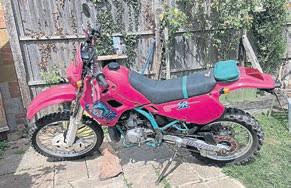








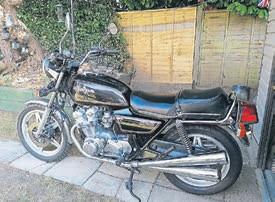






















 In partnership with Forcefield Body Armour
Brian Groves’ immaculate 1975 Honda CB400F
Jan Woolford’s hubby’s gleaming 1980 Honda CB750 KZ
Donna Price’s lightning-fast icon, the Kawasaki ZZR1100
Michael Parkes’ trick BMW RnineT
Sarah from Kent and her Suzuki GSXR, soaking up the views at Hunstanton in Norfolk
Chris Swani’s Ducati 916. We think this is one of the most beautiful bikes ever built
Mark Barge’s gorgeous Yamaha IT490. It’ll be on the VJMC stand at the Classic Motorcycle Mechanics Show
Ges Gilbert’s Steve McQueen inspired 1976 Z750 TwinDave Lawton looking as proud as punch astride his Suzuki Hayabusa
Mark Reed’s Honda Fireblade looks ready for action
Gregory Gilbert’s Kawasaki KDX SR looks pretty in pink
William Brook’s lookin’ good on his gorgeous Honda Fireblade
In partnership with Forcefield Body Armour
Brian Groves’ immaculate 1975 Honda CB400F
Jan Woolford’s hubby’s gleaming 1980 Honda CB750 KZ
Donna Price’s lightning-fast icon, the Kawasaki ZZR1100
Michael Parkes’ trick BMW RnineT
Sarah from Kent and her Suzuki GSXR, soaking up the views at Hunstanton in Norfolk
Chris Swani’s Ducati 916. We think this is one of the most beautiful bikes ever built
Mark Barge’s gorgeous Yamaha IT490. It’ll be on the VJMC stand at the Classic Motorcycle Mechanics Show
Ges Gilbert’s Steve McQueen inspired 1976 Z750 TwinDave Lawton looking as proud as punch astride his Suzuki Hayabusa
Mark Reed’s Honda Fireblade looks ready for action
Gregory Gilbert’s Kawasaki KDX SR looks pretty in pink
William Brook’s lookin’ good on his gorgeous Honda Fireblade
Money is tight for a lot of us at the minute.
living costs are causing plenty of people to have to scrimp and save and cut their spending where possible. But if you’re riding bikes and scooters, you’re going to have to spend a bit of cash to make sure you’re well protected should the worst happen and you end up trading blows with the Tarmac.
That’s why we’ve been finding out if it’s possible to kit out a biker from head to foot without breaking the bank. The gear would need to meet the proper PPE legislation - so there’s no bargain basement knock-offs here –but it would also need to be affordable enough for most people to afford after a few months of saving. That’s tricky.

To start with, we needed to set a reasonable budget. After a few calculations, we settled on £500. You could probably do it for a little bit less – but you’d soon be sacrificing safety and quality, and that’s not the way we wanted to go. So £500 it is. Here’s one way you could spend it if you do most of your riding in an urban environment.
It’s a fair bet the urban rider will spend a lot of time in their kit. Depending on dress code, it may well be worn to and from work, and even for leisure purposes after. That means it needs to be all-day comfortable, but still offer decent levels of protection if it goes wrong (though it doesn’t necessarily need to be rated for higher speeds). Here’s what we’ve found.

regular pair


happy
look
down

biker
with an
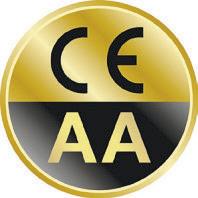
lining
proper
We’ve just broken the £500 mark this time round – although you are getting some top quality kit for your cash. That said, you’ll definitely be able to find cheaper options if you have a bit less to spend. We’ll be bringing you some even more cost effective kit solutions in the coming months.
Check out this funky little jet-style helmet from Shark. It features a VZ140 “long trip” visor with air inlet diffusers which allow for greater defogging and comes kitted out with two vents and baffles contoured for air flow around your noggin. Other than that, there’s a comfortable natural fibre interior, an ergonomic built-in drop down sun visor and an aerodynamic outer shell. Simple.

great
stylish
set of biking boots

like keeping things casual.
a few pairs
these and swear by




To be in with a chance of winning this cracking full-face lid from Duchinni, all you’ve got to do is identify the blacked-out bike in the image and send us your answer and your details either online or in the post. We’ll then pick the winner from an upturned helmet crammed with correct answers – and that person will be sent a brand-new helmet. It really is that simple. So, what are you waiting for? Get cracking for the chance to win. Good luck!
We’ve teamed up with the good people at Duchinni to offer you the chance to win a D977 full-face helmet. It might be on the more budget end of the motorcycle helmet spectrum, but that doesn’t mean it’s not a quality bit of kit and more than capable of helping to keep you safe should the worst happen and you end up trading blows with the Tarmac (or traffic).

Constructed from composite ABS and fibreglass, the aerodynamically designed D977 is kitted out with vents on the top and the chin bar (in addition to an exhaust at the rear), while channels through the EPS liner help to offer increased air-flow. There’s also a fully removable and washable interior; a breath deflector to help prevent visor fogging; a chin curtain to eliminate some of the wind noise; a micrometric quick-release buckle; and an anti-scratch clear visor
Not bad, right?
For more information visit: www.thekeycollection.co.uk

Flanked by the enormous bulk of Wales’ highest mountain, here’s how to enjoy different perspectives of the summit
Situated on the west coast of Britain, covering 823 square miles of differing landscapes, Snowdonia National Park is a living, working area, and home to 26,000 people. As well as being the largest National Park in Wales, Snowdonia also boasts the second highest mountain in the UK, Mount Snowdon. This major attraction daily witnesses hikers trudging their way over mammoth boulder fields to reach the summit, whilst others take the far more relaxed, easier option of the Park’s historic Snowdon Mountain Railway, which runs from Llanberis Those that make the ascent by boot or track are treated to stunning views across the sea to Ireland. Aside from the spectacular mountain scenery, Snowdonia is also home to an extensive network of trails, over 100 lakes and craggy peaks including Cader Idris and Tryfan. Travel here by bike and you will find yourself in a unique landscape of no fewer than nine mountain ranges covering around 52 per cent of the Park, with many peaks reaching over 915 metres (3000 feet). Contrasting with this stunning backdrop are steep river gorges, waterfalls and green valleys. Oak, ash, rowan and hazel woodlands are scattered throughout the Park, whilst the beautiful Dyfi, Mawddach and Dwyryd estuaries contribute to the overall diversity. Easily accessible by bike, many will travel the northern coastal A55 (watch for the speed restrictions) which begins at junction 12 at the southern end of the M53 motorway near Chester
The A55 crosses the River Dee and the border into Wales, passing close to Broughton, Flintshire, and passing north of Buckley, Penyffordd and Northop
What could be better than enjoying a ride around the enormous bulk of Mount Snowdon? Starting from Caernarfon, join the A4085, which will take you into the foothills. As you crest the hill having past RhydDdu, make sure you glance up left over the mountain’s flanks and you should be able to spot the summit café if it’s a clear day. Having arrived in Beddgelert, head left along the A498 and left again for a different perspective of the summit, this time being more jagged and triangular, and set amongst a horseshoe of cliffs. Once at Pen y Gwryd turn left and you will ride through Llanberis Pass. It is here, at Pen-y-Pass, which marks the start of Mount Snowdon’s most popular hiking routes. From here it’s a pleasant ride downhill to

Llanberis and back to Caernarfon. A lap of Snowdon is just a little taster of what this area has to offer. You can easily extend the ride by heading to Betws-y-Coed on the A4086 and the A5. From this beautiful, but busy town you have a couple of great options if you want to return to Caernarfon. You can take the A470 to Blaenau Ffestiniog over the Crimea Pass and enjoy the faster road with the dramatic slate-stone scenery. Or you can carry on a little further east on the A5, then take a right towards Ysbyty Ifan on the B4407. This is a much smaller road, with lovely mountain views. At the end of the road turn right towards Ffestiniog and Beddgelert if you want to return to Caernarfon, but don’t miss the Cwm Cynfal viewpoint soon after you have joined the B4391.



If you have allowed yourself enough time, and you fancy a walk up Snowdon, the quickest routes are from Peny-Pass, or you could always let the train take the strain from Llanberis, where you will also find the National Slate Museum. In Caernarfon, it would be a shame not to visit the magnificent castle. Once in Beddgelert it’s worth travelling a further 10 miles south to visit the tourist village of Portmeirion in Gwynedd. It was designed and built by Sir Clough Williams-Ellis between 1925 and 1975 in the style of an Italian village, and is now owned by a charitable trust.
In addition to its architectural heritage, stunning setting and sub-tropical gardens, you will find shops, cafes and restaurants, and an authentic Italian-style gelateria.
If you fancy heading underground, pop along to the Victorian Sygun Copper Mine in Beddgelert. The mine closed in 1903 but was renovated and reopened as a tourist attraction in 1986. Once a main supplier of minerals in Wales, today the mine focuses on audiovisual tours of the underground working. www.syguncoppermine.co.uk


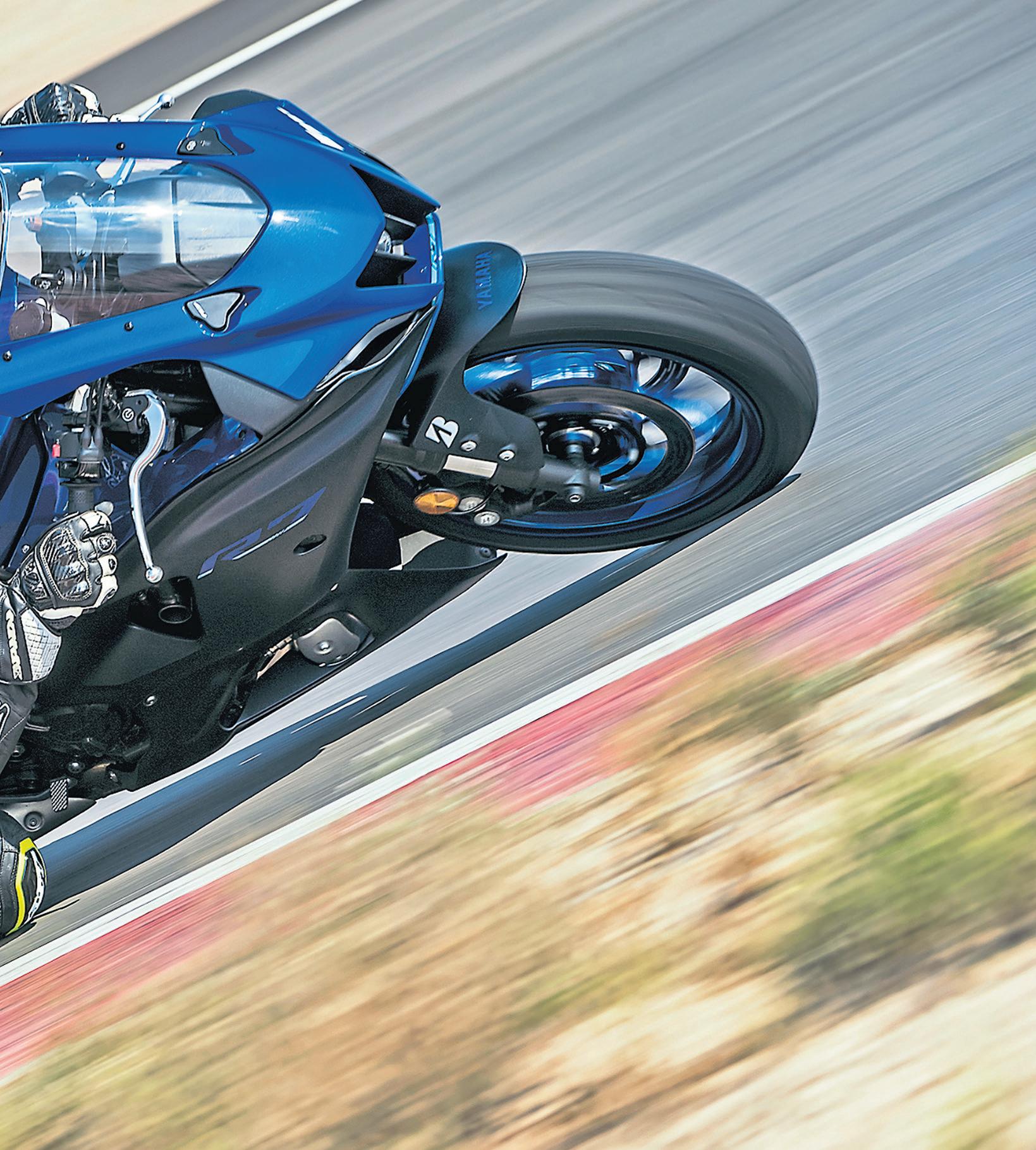
Of course, I’m talking about the R7, which has zero to do with the original R7 (OW-02) but hopes to open the door to new riders wanting a slice of sizeable sportsbike sauciness. It’s a fair shout and a worthy addition to the brand’s already extensive supersport line-up, bridging the gap from the entry-level R3 to the all-out R1 – and not just from the point of potency but affordability, too. Hitting UK showrooms from November, the R7 is refreshingly priced at £8200. The question is – what are you getting for your money?
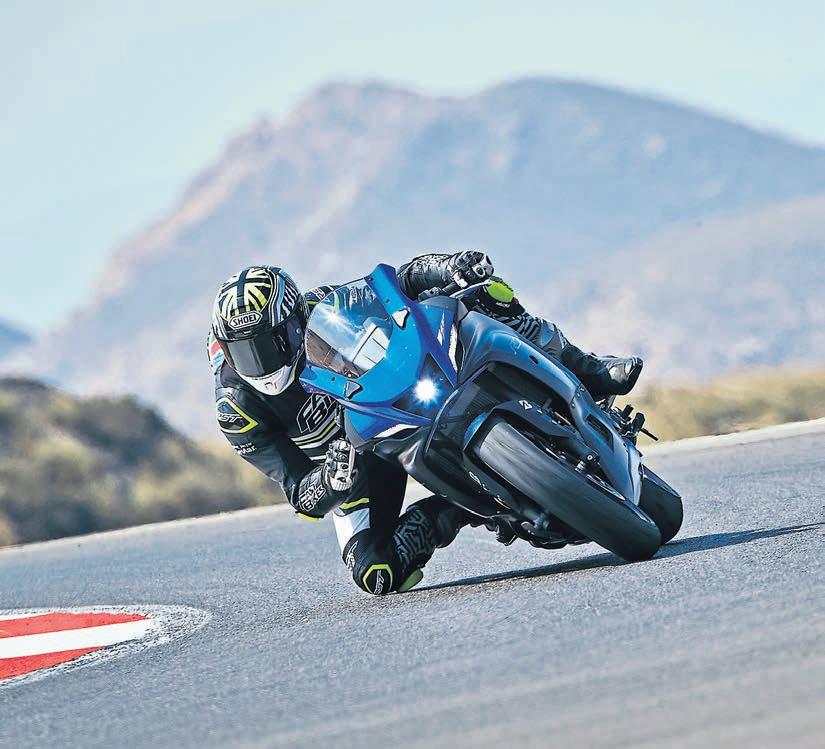
Unless you’ve been living under a rock, it’s been hard to escape the online onslaught suggesting the R7’s little more than an MT-07 in fancy dress, but that’s not entirely true. Yes, this sporty addition features the same proven CP2 motor that’s powered many a wheelie and good time at the hands of the MT-07, but it’s been nipped and tucked in all the right places to optimise its performance.
The ECU is different, the fuelling’s been enhanced, and alongside a whole new exhaust and air intakes, there’s now a slip assist clutch for good measure. The frame is another carryover component and that’s also gone under the scalpel, with the result being a 5mm reduced fork offset and a sharper rake to help the bike turn quicker, with additional bracing added to the frame to reduce torsional flex around the swingarm area. The R7’s been kitted with 41mm KYB forks that are fully adjustable for pre-load, rebound and compression, spaced 20mm wider apart than the legs on an MT-07, while the tweakable rear shock’s also new, with a revised shock length and a higher mounting point to encourage a more nosed bias disposition. Radially-mounted callipers are paired with dual 198mm discs up front, and a 16mm Brembo master cylinder is on tap to get you hauled up in a hurry.
The biggest difference between the R7 and the MT-07 is the look, of course, which mimics the R1 convincingly. It might not feature a smidgen of the tech you’ll find on the flagship

litre bike, but the R7’s LCD dash is beyond familiar – and the same goes for the enticinglystyled top yoke. As for the fairings, they’ve got all the styling cues of the model’s bigger brother, including the trademark M-shaped airduct up front and open tail on the rear seat. Even the tank’s been given the R treatment, with a similar silhouette and side-located gills as you’ll find on the R1. In aerodynamic terms, Yamaha claims the angular and narrow bodywork makes the bike 8% faster than the MT-07, while the ergonomics in place are said to have been taken from the headdown, arse-up R6. You get the point. With all of the above factors, plus plenty more subtle changes to areas such as the bike’s gearing and the addition of a new throttle pulley for more direct drive, the original MT-07 platform has been transformed from a head-banging middleweight naked into a credible, first big sportsbike... or so the model’s presentation would have you believe. The proof of the pudding is in the tasting, with the first course on offer being a 140km blast around Andalucía’s finest squiggles of road before a trip to the track for an all-out feast on the Yamaha’s potential.
First impressions count and the R7 didn’t disappoint. Hopping on to it ahead of the morning’s joyride, I was hit by how light the bike felt and how premium the general finish was, especially in the cockpit area where the tidy dash and yoke combo won my approval. In today’s money, £8k for a new sportsbike is pretty much unheard of and I’d half expected the R7 to be a little rough around the edges, with a few flimsy bits of plastic and the odd unsightly cable on show, but that wasn’t the case The bodywork looked spot-on and the flow of the design largely hid the bare bones of the less-than-sexy steel backbone frame nestled underneath. The high pegs and racy seat made me feel right at home, and I was both surprised and happy to find that the R7’s ‘bars weren’t those daft high-rise types you find on some wannabe sportsbikes. These were the real deal and completed an ergonomic
triangle that this model’s sporting forefathers would have approved of.
So far, so good – and the Euro5 spec exhaust note turned out to be tastier than I’d expected, emitting a throaty bark with every blip of the silky-actioned throttle. From a static point of view, the R7’s credentials appeared quite potent but my opinion rapidly changed the minute I got moving. Whatever way you dress it, 72bhp is pretty tame compared to most of the bikes we ride on a daily basis, faired or otherwise. Maybe I’d been a little
too optimistic and expecting the world, but that initial mile or two of the test felt a little lacklustre. Sure, the fuelling was faultless, and I was also impressed that the R7’s motor could run as low as 1200rpm without spasming in frustration, armed and ready to deliver drive the minute I wound open the throttle… albeit at a pedestrian pace. On the one hand it was frustrating, but on the other it was refreshing to ride a sportsbike with such pleasant manners, so suited to the mundane task of tootling through town without any angst or frustration.
If you like your bikes fast and your knee sliders mullered, you’ll probably want to get your hands on a copy of Fast Bikes. Each month we go farther, faster and fuller with our in-depth, honest and insightful new and used bike tests. As well as regular trackday advice, tested kit and all the latest goss from the world of two wheels, you can also expect to find monthly buyers’ guides, new product overviews and money-can’t-buy interviews from some of the greatest names in motorcycle racing. Whether you’re a naked bike lover, a pure-sports addict or someone that simply wants to discover great rides at home or away, we’ve got you covered… fast! So head to your local news outlet today, or www.fastbikesmag.com to check out what offers we’ve got in store for you.




It was a very easy motor to use and proved extremely pliable as we negotiated a relentless flow of high streets and roundabouts, and the odd tourist stepping out in front of us. But I wasn’t looking for decency and decorum; I wanted unadulterated performance, and I was left hanging. Admittedly, things got better when the pace heated up, free from traffic and meandering daytrippers. While the R7’s motor did not feel as vibrant and pokey as the MT-07’s platform, it came to life up in the hills where the throttle got wound to its stop. Just like the crossplane R1’s motor, the 270° parallel twin CP2 engine has a habit of bolstering your speed while sounding like its dawdling. It’s a sneaky companion, but a real charmer for that same reason. It
Yamaha’s gone all-out to make the R7 look the part. The 4.5-inch negative LCD dash mirrors the R1, alongside a similarly-styled top yoke and bodywork. Proper clip-ons and pegs offer a sporty stance, coupled with a high perched rider seat and a sizeable screen to get nestled behind, mimicking the ride triangle of the R6.

Yamaha’s chosen its proven CP2 motor to power the R7, developing it in several key areas to get the best from the package. There’s a new slip assist clutch fitted, a whole new exhaust design, and different air intakes to maximise performance. In addition, the bike’s got a new ECU to capitalise on the potent parallel twin package.
Lightweight 10-spoke wheels contribute to the bike’s look and handling. Radially-mounted four-piston callipers and 298mm disc rotors are there to offer good stopping performance, backed up by a Brembo radial master
cylinder. Bridgestone S22s come as standard, with a meaty 180-profile hoop at the rear. The battery is now lighter and smaller (1.1kg), but the overall weight of the bike (188kg) is 4kg heavier than the naked MT-07.
The R7’s been kitted with 41mm KYB forks that are adjustable for rebound, compression and preload. The adjustable rear shock sees a horizontal shock design and a new link mount to increase ride height. The bike’s frame is based on the MT-07, with added bracing around the swingarm mount and a revised geometry upfront with a sharper rake and a 5mm reduced offset.
It is 60 years since Yamaha got stuck in on the world scene. To celebrate that milestone, the R7 is being offered in an anniversary colour scheme. For £300 more than the black or blue options, you can own the fancy Anniversary Edition (£8500) that features all the greatness of its siblings, plus some Kenny Roberts inspired speed blocks… that must be worth a few tenths on your next trackday.
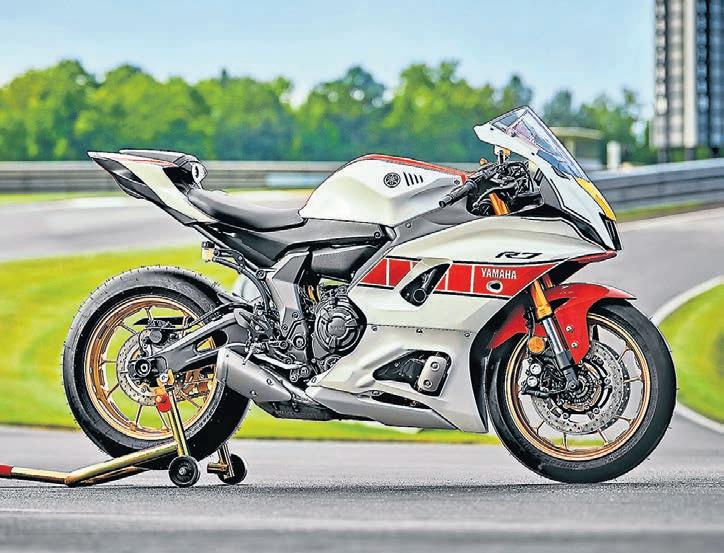


proved plenty fast enough for the road, but its best attribute was its handling. I’ve got mates who wear spandex, drink protein shakes and tense their muscles in the mirror at every given chance… and I’ve never known them lift 188kg. It’s a sizeable mass but Yamaha’s somehow managed to package those pounds in a very clever way, ensuring not just the stability of the bike but its effortless agility, too. It was a doddle to place the R7 wherever I wanted, smashing apexes like they were going out of fashion and making me feel a much better rider than I actually am. Given the choice of a powerful bike or a good handling option, I’d take the latter any day – and that’s what the R7 had to offer. It might not have been arm-wrenchingly quick but its fancy
footwork was insatiable and I was loving throwing it around.
Having stopped for a comfort break at the side of the road, I had a bit of catching up to do with my five counterparts. For the best part of three miles, up an Armco-barriered mountain pass, I did not hold back, asking myself and the bike for all there was to give. It was a memorable experience and showcased perfectly the potential of this refreshingly simple contender, blasting myself higher and higher up the winding road, skimming my knees with impunity on every given occasion, never once worrying about what traction control level was engaged or whether I’d chosen the correct level of electronically adjustable suspension. There was just me, the throttle, and the 500ft drop to my right to focus on.
By the time we’d reached Andalucía circuit I had a pretty good idea of the bike – whereas the track was a complete unknown. I’d never ridden there before and we were warned that the 5km layout was a little tricky, to say the least. We were also told that the R7 suited the layout’s flowing nature, and that third gear was as low as we’d need to go… we’d soon see We got three 20-minute sessions in all, with the only differences to our bikes being the colour (blue instead of black); the fitment of the optional extra quickshifter (there’s no blipper for some reason); and some supergrippy Bridgestone R11s in place of the stock fitment S22s. The first session was a waste, casually finding my way around the track without conviction, learning its undulations and late apexes as best I could.
The second outing was more meaningful and hammered home the brilliance of the underdog R7 in the most visceral of ways. Here was a bike that could pull me out of a pickle and compensate for my wild lines without complaint, somehow managing to keep me off the arid terrain that shouldered the track’s smooth surface. The litheness of the bike was surreal and the sure-footed confidence of the front end was nextlevel. I never once felt I came close to pushing the front tyre’s potential, despite setting some tasty times and riding as hard as I could during each session. The R7 was simply planted and reassuring, thanks to its talkative frame and KYT suspension, egging me on at all occasions to brake later, turn harder and carry more speed than I had the lap before. It was a really fun bike to ride, never once feeling intimidating or hard work to hustle, backed up by its sporting riding position that felt unequivocally suited to the circuit.
Admittedly, the R7 felt a little cramped after a decent stint on the road, but the high pegs, low ‘bars and tall seat perch made perfect sense on the circuit. The quickshifter did, too. The bike was bearable without one on the roads, but on track it especially made sense, particularly in certain corners where an upshift was an essential ingredient when it came to capitalising on the 72bhp on tap.
Around Andalucía, the lack of
ponies didn’t feel a horrendous ndicap – more n the last session where I was up to speed and pushing the bike as hard as possible through the endless supply of bends. It actually made for a more engaging and rewarding experience, for once being able to go full throttle without concern at full lean.

The Yamaha proved docile but not dull, making me feel as though I was the boss of it with every lap clocked. Sure, it wasn’t perfect, with a particular area of weakness being the average braking performance and the occasional engagement of the bike’s ABS, but the core of the package was commendable to the extent that I was able to overlook any negatives and
focus on the bigger picture, to see the gem in the rough and the potential this model has – not just for Yamaha but the larger sportsbike fraternity.



At times like these, we need models like the R7 to regenerate excitement and build new foundations for budding sportsbike riders – models that are not just affordable and good-looking, but delivering on the spirit that we know and love. If you’re used to litre sportsbikes, this isn’t the model for you. If you’re a hardcore 600 fan, this isn’t for you. If you’re that person that’s only ever dreamed of owning an original 0W-02, this isn’t for you. But for a mass of up-andcoming sportsbike riders, eager to take that next step in performance without fear or 100bhp too much, there is no finer fitment. This is the bike you’ve been waiting for.


















































































































Big touring bikes are designed to cover large distances in extreme comfort, and the general view is that they’re overweight, oversized and overpriced. So they’re all going to be exactly the same, and a little bit impractical for the highways and byways of the United Kingdom, right? Er. No…

To find out just how different two bikes that, on paper, fulfil exactly the
same role can be, myself and Mikko took the vee-twin Harley-Davidson Ultra Limited and Honda’s six-cylinder Gold Wing out for a play, taking in motorways, dual carriageways, A and B roads, and even some sketchy little back lanes to see whether bikes that most people would only consider useful for die-straight American interstates can be used on our tighter and twistier roads here in Europe.
Dave takes out the big guns from the States and Japan to see who’s the champion of the super-heavyweight class… WORDS: Dave Manning PHOTOS: Gary Chapman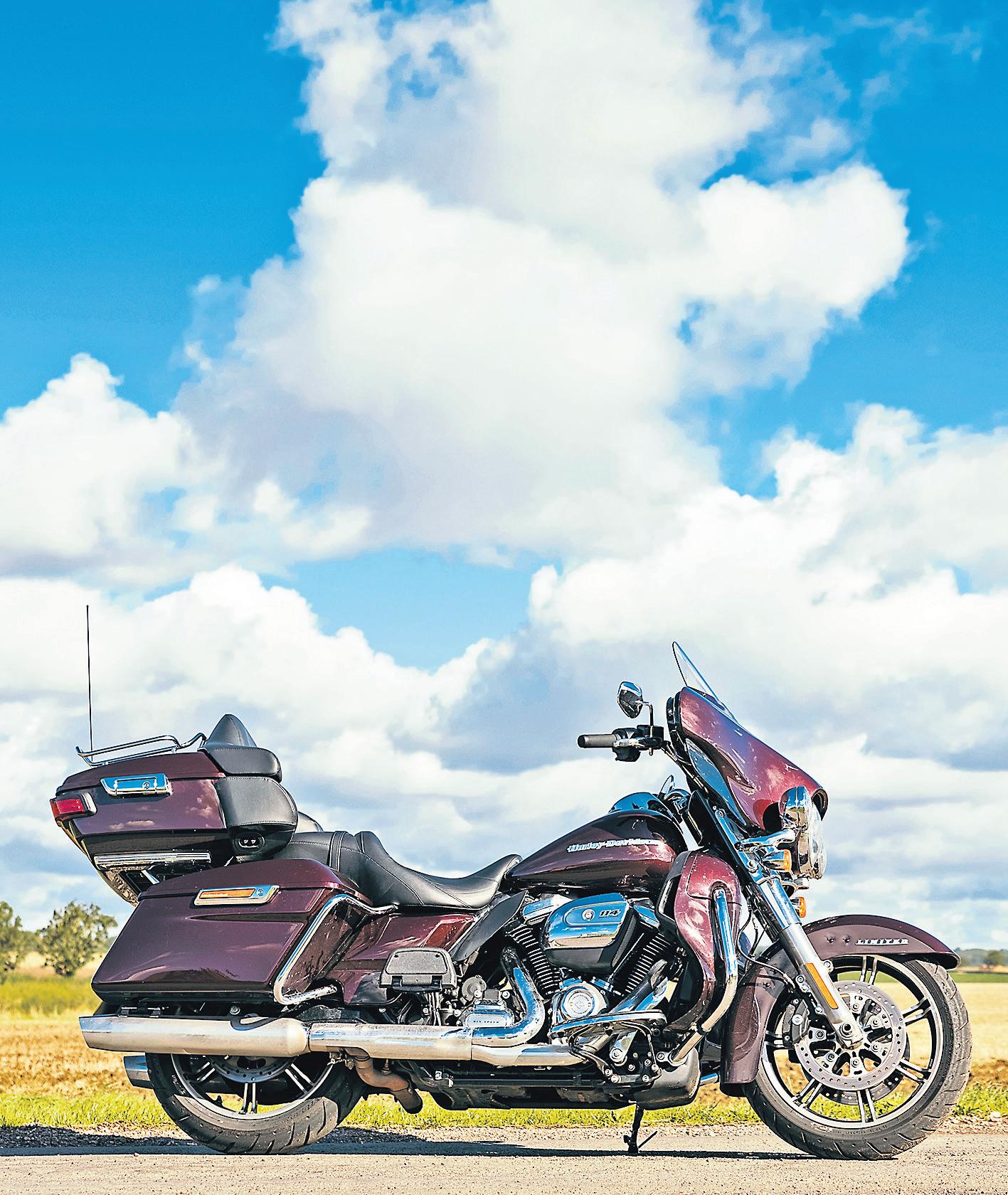
Yes, we can all see just how big the Harley is, but the first surprise is just how easy it is to move around at a standstill, especially if you’re pushing it backwards. Clearly the weight (all 416kg of it) is held low, but if you lean it over the slightest bit at a standstill, you soon get an idea of the mass involved
Once rolling, you still know that there’s a lot of bike underneath, but it is surprisingly easy to trickle around at tickover, feet up and with a feeling of stability only surpassed by a container ship. And when it’s time to get a shift on, the big 1868cc version of the Milwaukee-Eight vee-twin certainly delivers. While the horsepower figure of 87bhp may seem a little limp for a modern engine of 114 cubic inch capacity, bear in mind that that’s at a smidge over 5,000rpm – nothing like the stratospheric revs that modern sportsbikes reach. Once you get your head around the fact that it’s revving at about a third the rate of 200bhp/ litre supersports bikes, remember that the impressive 121lb-ft of torque
is delivered at a mere 3,000rpm. The fact that the torque is half as big again as that from a supersports bike means that, if you keep it around the torque sweet spot, it can haul its hefty 416kg around with some surprising ease. I wouldn’t say that it’s fast, but it is certainly no slow coach. It could be described as ‘not accelerating, but very swiftly gaining a lot of momentum’
The gearing also plays a part. In top gear, 55mph is 2000rpm, and 80mph (as shown on the speedo) is at just 3000rpm. This gives a really nice cruising speed that’s comfortable for both rider and bike. The seat is mega comfy and like a settee, but you are pinned into one position, which makes the footboards all the more practical as they do allow you to move your feet around and stop any numbness creeping in.
In rain, I was impressed by the excellent weather protection afforded by the Harley’s bodywork, with the screen proving effective
and not being overly noisy (take note Honda!) and the leg guards keeping the lower bits dry, too. The flip-side of that is the Ultra’s seat acts as a giant sponge and, when I sat on the HD two days later, my posterior was instantly soaked Somewhat frustrating, as every other manufacturer has managed to create seats that are waterproof.
The big issue with the wet, however, was that the Ultra felt really skittish on wet roads, with next to no feedback from the Harleybranded Dunlop tyres.
There are the usual chunky Harley controls. The switchgear seems fairly intuitive, despite the old-style indicator switches, with one on each bar – right for right, left for left.
The gearchange in the six-speed ’box is heavy, and slow, and feels unlike any other modern transmission. It feels rather agricultural, although there’ll not be any missed shifts as you’re left in no doubt that it’s shifted cogs. The shift is actually better when the bike is being revved harder.
Above: The panniers are efficient ‘top loaders’ that are easily removable if required

Right: The leg shields contain the radiators from the ‘twincooled’ (air and oil) system, and the rear side of each has a speaker, too
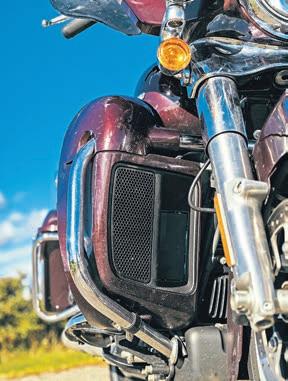

It will pull top gear from a smidge under 40mph, albeit with some complaint, but fifth is fine, although fourth is better for 30mph limits. But when in the sweet spot of 55mph and above, top is ideal. And while the long silencers on the dual exhaust system are very effective, giving out a mild wiffling at tickover, the rumbling that is emitted by exhaust and intake when given big throttle is addictive.
The brakes are pretty effective for HD fare, and haul the bike to a halt with three fingers on the front, and a gentle toe or two on the rear. And it actually hustles quite well, as long as you don’t mind the feeling of the front end shimmying around with the feeling that the fairing is the bit




that’s deciding where it wants the bars to be. Naturally, it’ll come as no surprise to hear that ground clearance isn’t a priority for this kind of bike, and the footboards do seem to have a magnetic appeal to Tarmac. Not that it spoils the experience though. In fact, it adds to it, with a giggle each time a board or boot heel skims terra firma.
Big tourers need big luggage space, and the Harley has a cavernous top-box The panniers aren’t quite as big, but still capable of holding a medium-sized rucksack, and they’re top loaders, too, which are so, so much better than the side-loaded efforts that vomit all your worldly goods on to the
floor each time you open them. Unlike the Honda, the HD panniers are really easy to take off, too, although I’m not entirely sure what the reason would need to be for you to do so.
Like many modern bikes, the Ultra has remote key locking, which is fine except when you need to refuel as you still need the barrel-style key to unlock the fuel cap. Cue frantic rummaging through your pockets… The heated grips get really, really hot. Of the six positions, I could only endure level 3 when wearing summer gloves, so despite the popular view of Harleys being summer vehicles only, I’d go as far as to suggest that this could be the perfect winter motorcycle, but for the sponge-like seat.

Stepping on to the Gold Wing after riding the Harley is like being transported to another world. The bike is, essentially, designed to perform exactly the same function as the Ultra, and the ergonomics are very similar, yet otherwise they couldn’t be further apart. The flat six engine is as smooth as silk; the transmission is the DCT seven-speed automatic; and the styling is angular and up-to-date. But does that make it better than the American offering?
It’s automatic, but I like it Trickling around at walking pace, the Honda doesn’t quite have the same feeling of bulk as the Harley, but it does have the feeling of unshakeable stability, which really helps your confidence in threading the bike through backstreets and city traffic, helped in no small part by the smooth automatic transmission (manual model is also available).
My initial thoughts about Honda’s Dual Clutch Transmission automatic gearbox had been rather dismissive, but I have to say, it really is rather likeable. The DCT system has a lovely operation once you get used to not reaching for a clutch lever, with a seamless shift between gears that is perfect for riding with a pillion.
Overtaking is easier in Sport mode, thanks to the fact it’ll downshift on large throttle openings and let the flat six rev out a bit more, while Tour is a little gentler and rewards greater foresight for overtaking.
The handling seems more precise than the vee-twin, and while there’s occasionally a feeling of understeering thanks to the DCT transmission being off the power rather than just a trailing (or even positive) throttle if you’d downshifted a little earlier, a touch of rear brake does tighten up the corner and improves confidence. The other two modes (Rain and Economy) were, for me, irrelevant, as the drive is so sweet and smooth in Tour I felt that I didn’t need a softer option.

While the Wing is even quieter than the HD at tickover, it also has an impressive and addictive engine tone when hard on the gas – the flat six gives the impression of being a big V8 diesel, both in sound and power delivery, with a feeling of immense torque and of being shoved forward by a giant gloved hand. Rather surprisingly, the Honda actually has more torque than the similarly-sized Milwaukee-Eight, and more power, too, at 124bhp.
The Wing is pretty quick, too. I’d go as far as to say that if you were travelling cross-country with a passenger - over distances of greater than a couple of hundred miles –and you wanted your passenger to be able to walk at the end of the day, then the Wing would be the fastest bike available on which to do it.
For a pillion the ride is great, and the Honda does have more support for the pillion in terms of those seat ‘ears’. The pillion seat is heated (as is the rider’s seat), with the control easily reached by the passenger.
The tops of the Hossack-style front suspension units can be seen while riding, and they really give you a sense of how hard the double wishbone suspension works, even on relatively smooth roads – actually, they show that no road is entirely smooth! They have been criticised as being a little more vague feeling than the telescopic forks fitted to the previous model of the 1800cc Wing, although I never found this to be an issue, and it engendered far more confidence than the H-D on twisting Tarmac, especially in damp or wet conditions.
Incidentally, when the Gold Wing was updated a couple of years ago (with the Hossack forks), the project leader was a certain Masanori Aoki,
who had previously been involved with the development of several CBR supersport models, and it’s clear that a focus on sharp handling was strong.
The top-box, which, like the panniers, is incorporated into the bodywork, can hold two full-face helmets, while the panniers are side-loaders, with a total luggage space of 121 litres (11 litres less than the HD). To aid parking, an electric reverse is fitted, although it can also be used to go forward, which seems a little peculiar, given that it’s equipped with the 1.8-litre flat six internal combustion engine that can also make the bike go forward… The Wing has a centre stand, although one has to wonder why, given the shaft drive, and also has a handbrake, which is sensible given that you can’t park the DCT version in gear.
Like the Ultra, the Wing has remote key locking, although unlike the Harley everything is electronic so the key doesn’t need to be dug out of your jacket pocket when you need to refuel, although there is still the




masonic handshake that is required to actually get to the fuel cap itself. I’m not going to give the secret away, but it does involve a hidden switch behind a not-very-obvious flap…

Price: Starting at £22,849 (featured model £31,599)
Engine: 1833cc flat six, water-cooling, 24 valves, single overhead cam, 7-speed DCT transmission
Power: 124bhp (93kW) @ 5500rpm

Torque: 125lb-ft (170Nm) @ 4500rpm
Frame: Tubular & box section aluminium double cradle
Wheelbase: 1695mm
Brakes: Twin 320mm discs, 6 piston Nissin callipers (F), 316mm disc, 3 piston Nissin calliper (R)
Transmission: 7 automatic gears with reverse, shaft final drive
Suspension: Hossack-style single shock dual wishbone forks (F), single Pro-Link shock (R)
Wheels/tyres: 3.5x18” cast aluminium wheel, 130/70xR18” Bridgestone Exedra G853 tyre (F), 5.00x16” cast aluminium wheel, 200/55xR16” Bridgestone Exedra G852 tyre (R)
Seat height: 745mm
Fuel capacity: 21.1 litres
Fuel efficiency: 48mpg
Weight: 376kg (dry) 390kg (wet)
Warranty: 3 years, unlimited mileage, transferable
Service intervals: 4000 miles / 12 months
It may look nothing like a motorcycle engine, but the flat six is rather endearing in use
The Wing’s car-like features include the electric reverse gear; the stereo; the big 7” TFT screen and satnav; the heated seats (rider and pillion); and the handbrake Panniers (30 litres each) are built-in side loaders, which aren’t as easy to use as the Harley’s top loaders without inner bags Below: The 61-litre top-box takes two full-face helmets with room to spare The pillion seat has heating with easily-reached controls Handbrake is required for a DCT bikeBoth the Harley and the Honda are ace motorcycles, surprisingly adept at being ridden just about anywhere that isn’t off-road, and are a wonderful place to be in when you want to cover a lot of miles on a motorcycle. Or even just a few miles for that matter. They both attract an impressive amount of attention when you’re parked up, as even non-motorcycling folk know of Harleys and Gold Wings, and you will most certainly get into more conversations with Joe Public when on one of these two than on any other type of bike.
If you want a sporty side to your comfortable touring, the answer is Japanese. For fast touring, the Honda is far better – the handling is sweeter, the power delivery is more direct (especially in Sport mode), and the ground clearance is better (although you’ll still be leaving sweeping arcs on the road if you’re pressing on), and the smoothness delivered by the DCT transmission is a boon for anyone who tours with a pillion, as your passenger will thank you for the silky gear changes preventing any lurching and helmet-clashing.
If, however, you want a bike that retains its value a little more, one that absolutely everyone recognises, and to have a bike that raises a giggle each and every time you ride it, without fail, on a machine that has character and charisma, then you’ll want to go American.
There are those folk who suggest that you can tour on a motorcycle at a much, much lower cost than it takes to buy one of these two monsters. And


they’re right. But if you have the requisite amount of folding to be able to buy one, then why wouldn’t you want the epitome of a touring motorcycle, with more comfort for two people than any other bike on the market, with all the bells and whistles that you’d ever need, with both being machines that are not only pleasurable and comfortable, but also an absolute hoot whenever you want?
So, basically, if you just want to have fun and tour in comfort, then flick a coin, pay the man and go out and ride.
“So, basically, if you just want to have fun and tour in comfort, then flick a coin, pay the man and go out and ride.”





























With the launch of the newest iteration of Yamaha’s R7 in this issue, it seemed like the perfect opportunity to show off the original icon; the 1999 Yamaha YZF-R7 OW-02. Our pals at Fast Bikes have been lucky enough to ride one, so we’ll be bringing you a full road test in the next issue.

There’s a long-held myth that pressure washing your bike’s a bad idea. But if you do it properly, it’s the quickest and easiest way to keep your pride and joy in tip-top condition for years to come.
We’d all sooner be out riding our motorcycle than we would washing it, but if you want to keep your bike in tip-top condition, you’ve got two options – you either never ride it, or you learn how to clean it properly. The easiest way to do it is with a pressure washer.
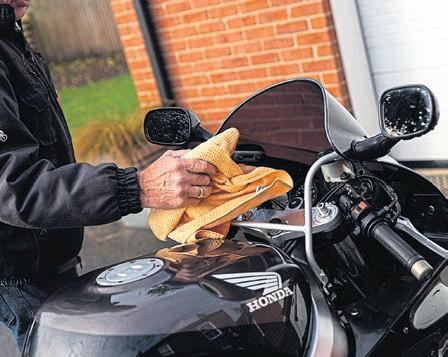


Don’t just dive in, though. A pressure washer is a power tool, and like any power tool it has the potential to cause damage if you use it in the wrong way. But with a few simple tips and tricks, a pressure washer’s a very effective tool for cleaning your bike down and making sure it stays in the best shape possible.
To make sure we’re not going to cause any problems with a pressure washer, the first thing we get our operators to do is a quick walk around check. It should take no more than a minute. During the walk around, we’re looking out for a number of things, including how dirty the bike is, where the dirt is, and what type of dirt it is.
Secondly we’re looking to see if there’s anything on the bike that is going to be affected by using a pressure washer – is there anything loose, broken or damaged? Are there any loose decals, exposed wiring, air intakes and electrical enclosures to watch out for?


By walking around and looking at the bike, you’re establishing the things to watch out for when you start to use the pressure washer and determining what you’re going to do at each stage It’s simple preparation. You wouldn’t drill a wall without checking that there are no cables or pipes behind it, and it’s the same principle when you’re pressure washing a motorcycle.
Another simple technique is to change your perspective with a tilt of the head – it allows you to look through the bike and see sections that often get neglected. When you’re working a specific section, you can also rest your hand there. It’ll help to refocus your attention, and hone in on a specific area of the bike.
It’s surprisingly difficult to get people to look beyond what they see and focus on a specific section closely. As a result, the observation technique is arguably the most essential part of pressure washing your bike. The skills and techniques outlined are employed right through the cleaning process.
No matter whether you’re checking the bike over or using the pressure washer, you should work in sections Don’t think of it as a bike, rather think of it as a series of different sections which you’re working your way through methodically. Start at the front end, move on to the cockpit, then to the tank and seat, around to the engine, and then around to the rear end before working your way around the other side of the bike back to the front.
There are three types of dirt. There is loose surface dirt, there is bonded dirt and there is ingrained dirt. The pre-rinse is designed to take off the loose dirt; shampoo and cleaners will tackle bonded dirt; and ingrained dirt will generally need a more aggressive cleaner or to be polished out.
Most people think of a pre-rinse as wetting the bike before shampooing, but that’s not the case. With the prerinse, nothing we do is for the sake of doing it; everything has a specific purpose. The pre-rinse’s job is to do two things. The first job is to remove any loose dirt, so it doesn’t mix with the shampoo The second job is to rehydrate dirt that’s been baked on to a hot engine or exhaust and help the shampoo to work more effectively.
There are two things that people tend to do when they’re pressure washing a bike. They zig-zag – going from one bit, to another bit, and then back to the first. It’s an inefficient way to clean the bike; they’re expending energy and time, while wasting water.
Secondly, they’re usually scared of getting too close with the pressure
washer. Manufacturers design bikes to be waterproof. Everything is shielded from rainfall and potential water ingress. If you work from the front end to the back, you’re using the design of the bike to your advantage It’s capable of being hit by rain at speeds in excess of 70, 80, 90mph.
As a result, when you’re cleaning the bike with a pressure washer you can use most of its force, providing you work along from front to back. You can get in close. But when you turn around and work the other way, you’ll have to be more careful. It’s designed to handle rainfall – not a high pressure jet of water. So, what do you do? You pull back.
The pressure washer is a tool. You can use the stream of water in different ways for different purposes, depending on how close you get. The best way to get used to using the pressure washer’s power is to break it up into zones.
Zone 1. The first 5cm from the nozzle. Do not use. It may damage the metal on the bike.
Zone 2. 5-20cm. You’ve got pressure there – but not quite enough to cause damage to metal. Think of it as a hard brush.
Zone 3. 20cm-50cm. Effectively a soft brush setting for working on any more delicate areas.
Zone 4. 50cm-150cm. Rinse setting.
Zone 5. 150cm onwards. Misting.
Perfect for when you get around to shampooing the bike. It means you can hydrate the product and stop it drying out.
■ If you can get your bike on a centre stand or a paddock stand, it’ll make it easier to get to those hard-to-reach parts (as well, as making it easier to clean the back wheel).
■ With a pressure washer, one of the first things to do when you turn it on is to purge it through. Before you even switch it on, let any airlocks and dirty water through first.
■ Most pressure washers come with a couple of different settings or nozzle attachments. There’s usually a high pressure one which is capable of descaling concrete. We don’t want that on the bike. It could do some damage. We want the low pressure one.
■ Work in sections – but make sure you’re going top to bottom, too. There’s no point in cleaning a wheel if you’ve not properly cleaned under the tail. There’s no point cleaning the engine block if you haven’t already cleaned the tank.
■ If you follow the advice, you’re not going to do any damage to seals or bearings, because you’re not applying the pressure washer for long enough or in a specific enough direction to force any water through.
■ Cleaning your bike thoroughly will keep corrosion at bay, but it’s also the perfect opportunity to give it a careful onceover and look for any issues and faults that you might have missed as you roll it out of the shed to go for a blast.



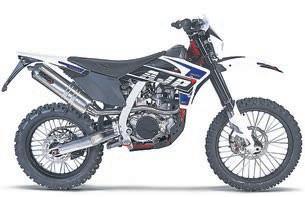
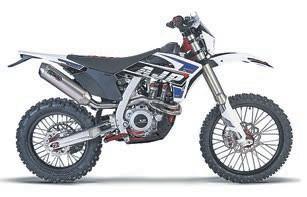
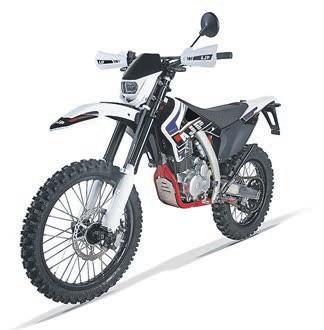


































As part of Royal Enfield’s grand plan to dominate the middle-capacity market, in 2021 it launched the Meteor. A simple 349cc single putting out a modest 20bhp, at the launch everyone loved it (the standard phrase being, ‘It was a total hoot to ride’). I got to test it shortly after and, like everyone else, I loved it. And still do. Every time I drop off a bike at my local Kawasaki/Enfield dealer, I’m always happy to take the Meteor as a loan machine.




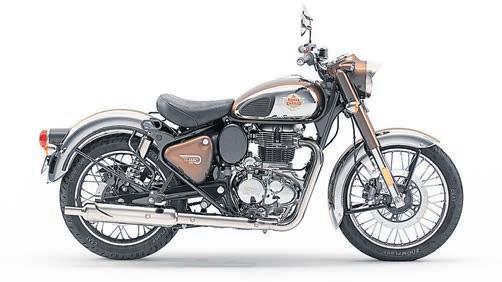
Enfield’s actually developing a whole range based around the same engine. In 2022 the Classic launched, and 2023 sees the roadster-styled Hunter. The Hunter’s not going to be landing on British shores for a few months, so ahead of its arrival we thought we’d take a look at the two you can buy.
On paper, there is little difference between the Meteor and the Classic. Same engine, same frame, same power and torque. So what’s the story, Enfield? Are you asking me to pay £400 more for the same bike, just dressed in a vintage frock? The lovely people at Bacons Motorcycles set me up for the day trying the pair out to see how they compared.
First up, the Meteor. It’s baby-cruiser
While other manufacturers chase more power and more technology, Royal Enfield’s back-to-basics 350cc singles hark back to a simpler time.
styling has proven a big hit; I know whenever I’ve borrowed one it turns heads, bikers and non-bikers alike. It’s a lovely place to sit; upright, an easy lean into the bars, big comfy seat cosseting the rider and pegs slightly forward of centre is a very comfortable place to rest your legs. Be aware, it is broad in the beam, so despite that 765mm seat height, my feet (29-inch legs) just rest flat. The Meteor is so easy to ride. The riding position is so relaxed and just right to guide the little Enfield through the bends. It feels light and nimble, with the 140-section 17” rear rolling the Meteor round bends. The clutch is featherlight and the heel/toe gearchange is one of the best I’ve ever used, snicking positively into gear. In town it’s a doddle, nicely balanced and will trundle at the slightest twist of the throttle. Big A roads probably suit it best, allowing you to settle into a groove and flow from bend to bend. Back roads? The light handling makes it fun, but again floating through the bends suits it best, enjoying the light, if not totally accurate, handling. Motorways aren’t ideal. It can hold 70 well enough but the upright stance is hard work after a while.
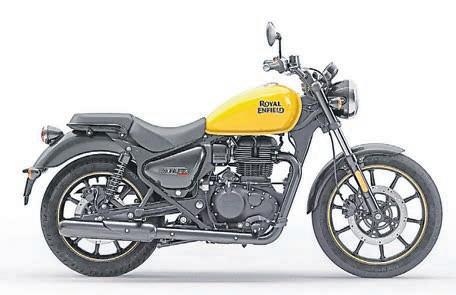 WORDS and PHOTOS: Bob Pickett
WORDS and PHOTOS: Bob Pickett
“The Meteor is so easy to ride. The riding position is so relaxed and just right to guide the little Enfield through the bends.”
Common fallacy, there is no engine braking. Like all singles, it’s there, but on the Meteor you just never open the throttle enough for it to become a factor! The first time you roll off on a Meteor, I guarantee it’ll be closely followed by your eyes popping wide open as it doesn’t slow down!
Fortunately the ByBre brakes are more than enough up to the job. They’re not fancy, but they have all the power you need with decent feel at the lever. If you want to push on, the little 349cc single will oblige. It’s perky and happy to work.
You just never feel the need to rev the Meteor. Just find a comfortable place in the rev range and enjoy the world, safe in the knowledge you could ride all day in total comfort, gliding from one bend to the next with a big smile on your face.
Next, the Classic. Enfield knows a bit about classic styling (after all, the Bullet ran almost unchanged from 1949) and it’s got it just right, with nice touches like the flat clock (which isn’t as easy to read as the Meteor’s upright one. The Classic does not come with Enfield’s Tripper navigation system.).

I dropped by at a classic restorer I know, who had nothing but praise for the looks.
The Chrome Bronze scheme on the bike we tested certainly has the looks, but personally I’d go for Halcyon Grey, which has less chrome and gives it a lovely 1960s vibe.
The Classic’s perch is 40mm higher than the Meteor, but it’s so much slimmer and my feet touch down flat more easily. The riding position feels more like an old cafe racer, with

flatter bars and the footpegs slightly rear of centre. Again, it’s a nice place to sit, but the peg placement has you dragging your legs backward whenever you come to a halt.
The extra 4kg makes itself apparent when you first lift it off the stand.
A combination of extra weight and riding position, the Classic feels much heavier than the Meteor. The clutch also feels heavier, but the conventional gear-change is positive, clunking solidly into gear. One thing: the gear arm is very shiny, and a couple of times I went to change down, missed the rubber and my foot slid off the peg!
Once rolling, the riding position makes sense. It’s still relaxed, but the different geometry makes the Classic work in a different way to its baby-
cruiser sibling. Leaning into the flatter bars more puts extra weight on to the front, and added to the taller, slimmer rear has the Classic tipping rather than rolling into B road bends, with more accuracy and assurance than the Meteor. It also felt more stable on the motorway; the more tuckedin stance and extra weight aids the Classic at higher speeds and you’ll find yourself pushing the front harder and revving the engine more. It’s not such a good town bike, though. The heavier clutch can become hard work and it needed a firmer squeeze on the brake lever to haul it up.
So which is the better bike? I’m surprised at the difference between the two that, on paper, are essentially the same machine. The subtle changes in geometry make for two
very different bikes. They’re both a joy to ride, and ultimately it comes down to how you like to ride and where you do most of your riding. If you spend most of your time on backroads, then go for the Classic. The riding position and smaller rear wheel allow you to push into bends in a way the more upright Meteor cannot match. But if you spend more of your time on A roads (or commuting) then the Meteor is the one to choose. As long as you eschew motorways as much as possible, it’s also the better long-range mule with it’s relaxed riding position and ride.
As we said earlier, next year these two are joined by the Hunter; with a totally new frame it will have a shorter wheelbase, steeper head angle and be much lighter (perhaps making it a better commuter than the other two, but time will tell). The lightmiddleweight class is becoming a very interesting place to explore.
Price: £3,879 to £4,039 depending on colour Engine: 349cc single, 4-stroke SOHC, air-/ oil-cooled Power: 20bhp/14.87kW @ 6,100rpm
Torque: 19.9lb-ft/27Nm @ 4,000rpm
Transmission: 5-speed constant mesh, chain drive
Frame: Twin downtube spine frame
Suspension:
Front: Telescopic 41mm forks, 130mm travel

Rear: Twin tube emulsion shock with 6 step adjustable preload Dual channel ABS Ground Clearance: 170mm Wheels:
Front: Cast wheel – 100/90-19” – 57P
Rear: Cast wheel – 140/70-17” – 66P Brakes:
Front: 300mm single disc with twin piston floating calliper
Rear: 270mm single disc with single piston floating calliper Wheelbase: 1,400mm Length x width x height (mm): 2,140 x 845 x 1,140
Seat Height: 765mm Weight: 191Kg (in running order) Fuel Capacity: 15 litres
Price: £4,279 to £4,439 depending on colour/ chrome Engine: 349cc single, 4-stroke SOHC, air-/ oil-cooled Power: 20bhp/14.87kW @ 6,100rpm
Torque: 19.9lb-ft/27Nm @ 4,000rpm

Transmission: 5-speed constant mesh, chain drive
Frame: Twin downtube spine frame
Suspension:
Front: Telescopic 41mm forks
Rear: Twin tube emulsion shocks with 6-step adjustable preload Ground Clearance: 170mm Wheels:
Front: Spoke wheel - 100/90-19” - 57P
Rear: Spoke wheel - 120/80 - 18” - 62P Brakes:
Front: 300mm single disc with twin piston floating calliper
Rear: 270mm single disc with single piston floating calliper dual channel ABS Wheelbase: 1,390mm Length x width x height (mm): 2,145 x 785 x 1,090
Seat Height: 805mm Weight:
“Extra weight aids the Classic at higher speeds and you’ll find yourself pushing the front harder and revving the engine more.”















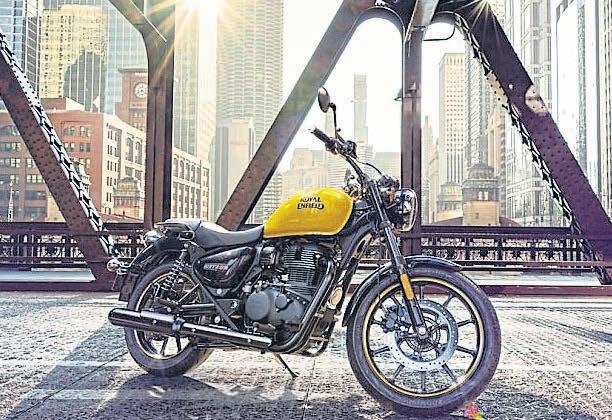








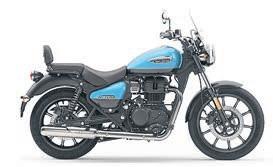
Marketed as a ‘Blade Beater’ when it arrived, the second-generation ZX-9R Ninja was lighter and faster than ever before, but it was by then up against the Yamaha YZF-R1…
 WORDS: Bertie Simmonds PHOTOS: Gary Chapman, Mortons Archive
WORDS: Bertie Simmonds PHOTOS: Gary Chapman, Mortons Archive
I’ve always batted for the biking underdog, I can’t help it. If something was the best, biggest and baddest, I’d be going for the also-ran.
So, in 1999 I had a Kawasaki ZX-9R for a year and did the best part of 25,000 miles on it, therefore this test is like meeting an old friend once more…
Of course, back in 1994 the first model ZX-9R Ninja was billed as a ‘Blade Beater’ , but was anything but. Fast and comfy, the B-model was half ZZ-R1100 meets ZXR750, so the early Honda CBR900RR FireBlade models had them beat as sportsbikes as Blades were so much lighter by comparison, so Kawasaki decided to wield the knife and cut off some lard.
At the end of 1997 came the C-1 model and the bulky looks of the original machine were replaced with a much leaner, shark-like menace
to the aesthetics. At 183 kilos, the C-model was a huge 32 kilos lighter (dry weight) than the outgoing model, 20 kilos lighter than the ZX-7R, about the same as that year’s FireBlade, and even only a kilo heavier than little brother, the ZX-6R. Power was also up to around 143bhp at the crank (say, 125 at the rear wheel), which again was about 10-15bhp up on the previous model, which was born at a time of some Euro ‘gentlemen’s agreement’ to not push past 125bhp…
Saddling up this green meanie (mine was the blue model – sigh) is just like stepping back in time 22 years. As you approach, you can see the word TITANIUM proudly emblazoned on the large, shiny endcan. Apparently this was important – only aftermarket cans were normally made of this metal and Kawasaki clearly wanted to tell riders that
Ah… S528 JJH, my blue ZX-9R Ninja C-2 – we did so much together. For us bigger lads it was a lot more comfy than an R1 even if it didn’t offer the same cool looks and kick-in-the-pants performance. That said, it wasn’t far off and was plenty fast enough for anyone without a death wish or an urge to go to prison for speeding.

Long-term bikes are given to a lucky few and I speak from experience that many journalists think they are a God-given right. I never did and always tried to gel with any bike I was lucky enough to be handed.
I would do my 60-mile daily commute on her; I would do various UK and European tours; take in a couple of track-days; and a colleague even took her to Morocco for a jaunt.
Back then we all had a hankering for making bikes ‘unique to us’ and so it proved with me. I got a ‘just about colour-matched’ pillion cowling; an NWS carbon-fibre rear hugger; an MPS double-bubble smoked screen; and even had the bike stage-one tuned by PDQ to try and claw back the deficit on a standard R1. On went a lightweight Hindle pipe, in went a Dynojet kit and K&N airfilter. After a few dyno runs we’d gone from 129.6bhp up to 138.7bhp. Not sure if that was at the crank or the rear
Engine type:
Claimed
Transmission
it’d been serious in its diet.
The riding position is sporty, but comfy – more so than the rival R1, less so than the (by then) less-honed, softer-edged FireBlade RR-W/X. Fire it up, pull on the choke lever and hear the traditional Kawasaki high-revving choke kick in, so knock it back a few mm. Even on a standard pipe there’s a satisfying burble from the 899cc inline four. Casting your eyes over the clock-set, it’s a pleasing old-school/ new-wave mix of analogue clocks and LCD readouts and gauges.



Even just sitting on the C-model, if you’ve ridden a B you can feel this package is lighter and more purposeful. Lightly snick the Ninja into first gear, let out that light, cableoperated clutch and away you go.
Whoa! This thing still pulls like a ruddy freight train (other clichés are available); even compared to the ZX-
tyre… it was more than 20 years back and my memory is shot…
I kept it clean and tidy, so the paint never fell off the wheels as it could and the Tokico six-pots worked well and benefitted from EBC double-H pads and Goodridge hoses. Carb icing did occur (it felt like you were running out of fuel) but cleaning the coolant filter did help.
By the time I left the magazine my beloved 9R stayed with them and it did suffer a little, thanks in part to a batch of iffy Dynojet kits; power became way too peaky over time, but PDQ sorted this out.
During my year with it, the bike did 25,000 miles and was stripped down at the end of it. All that was found was a badly seated main bearing, which probably occurred at the factory. Expert analysis said this wouldn’t have caused a premature failure of any kind anyway.
Apart from worn consumables (brake discs were on the limit, the forks had sludged up and the rear shock had lost gas in the remote reservoir) it was as robust as the day it left the factory.
What happened to S528 JJH afterwards is lost in the mists of time... one errant, experienced journalist did dump it in 2000 and then it stayed in the care of BSD
tuners/bike experts for a while where I tracked it down in 2001 and tried to buy it to become a track-day tool for myself. Sadly. Kawasaki wanted it back.
Records now show that S528 JJH is SORN and last had an MoT which expired in July 2021. I’d love to be reunited with her once again!
10R I’ve just ridden for a photo shoot, this compares well. From around 3000rpm you get instantaneous urge through that back tyre and it does nothing but surge forward through the revs and gears; soon you’re through a meaty mid-range when things start to take off again around 8000rpm, before you hit that dizzy 12,000rpm redline. This thing has still got it…
The accompanying soundtrack is what makes this throttle-wanging addictive. As mentioned, even the standard silencer gives some throaty backbeat, but this is aided and abetted by the wonderful induction roar through those twin nose scoops into the RAM air system. Like with the earlier ZX-6R, Kawasaki fooled about with the air-box and routing system to push the lovely noise up into the cockpit. The result is a cool, cacophonous crescendo which is just a twist of the right wrist away.

Handling is measured, not oversharp, but (again, if you’ve ridden the B-model) you can feel the lighter weight and the shorter (by 35mm) wheelbase. As I recall of mine (reinforced by this lovely example) the forks which are 46mm conventional right-way-up behave well over most surfaces but the rear shock still does what my one used to at times, and that is thump you up the bottie over the harsher bumps. You can adjust this out unless you’ve an issue with a lack of gas in the remote reservoir.
Brakes are those much-maligned six-pot Tokicos – and I can say hand on heart that I never had any of the issues many others have had with them back in the day. Keeping the callipers regularly cleaned is the important bit and the ones on this bike performed admirably enough. An initial squeeze of the lever starts predictable retardation, then a final bigger lunge for the lever and you still get decent braking performance.
If there is an issue with this example, I’d point to the tyres. I never felt completely confident in these Chinese-made boots whose name I didn’t even recognise. It all smacks a bit of putting a ballerina in hobnail boots and asking them to perform… They’d be the first thing to go.
And now the elephant in the room – the YZF-R1 that came out the same year. Yes, the 9R was giving away 99cc to the Yamaha; yes the 9R would ‘only’ be pumping out 85bhp at 7000rpm on a dyno compared to the R1’s 105 at the same revs but, well, even in back-to-back tests of the time, the Kawasaki still didn’t feel too far off the R1 for outright power and pace, it was when a corner arrived that things changed a bit.
Overall though, I’m still mightily impressed at what smiles this bike can deliver. On mine, I toured, trackdayed, commuted, even took a pillion a few places (the rear seat is twice as comfy as that on the R1 and you’ve actually got pillion grab handles) and generally had lots of fun, often running into the issues many owners faced. These included carb icing – a bug-bear of Kwaks at the time. Early C-1 models were the worst, having only one carb heating rail. Basically, coolant from the cooling system is fed via a small pipe through a filter and to a set of brass conductors which heat the carbs. On the C-2 model two rails were fitted but the problem could still occur on some bikes. Later models (E-series on) don’t seem to suffer. Things to help included clearing out the (often clogged) coolant filter; recharging the cooling system to get rid of air in the system; fuel treatment such as Fuchs Pro Fuel System can help; and some owners actually fitted a higher temperature thermostat (up from 62 to 80 degrees) from a Toyota car! Other issues could see the forks ‘go soft’ and turn the oil into a sludge, often making the fork seals go pop, and the rear shock’s remote reservoir loses gas sometimes, too, but suspension experts can sort that out. Some owners of the C-models
reported the odd gearbox issue with false neutrals and jumping out of gear. Apart from that, the finish of the bike can suffer – especially wheel paint, if you don’t look after the bike properly.

Now it’s time to show you all why this second-string sportsbike is now a first-rate choice: it’s time to talk today’s prices and here’s where backing the underdog can work today. These bikes are ridiculously cheap compared to a similarly-aged Yamaha YZF-R1. In some instances, I’d wager they offer three-quarters of the performance, for half, or even a third of the price of the Yamaha…
Go look see. We’ve seen tidy 1998 C-1s for £2100 with less than 20k on the clocks at a dealer no less… Or the same colour C-2 as this one, with 49k on the clocks for £1700. Many bikes
identical (but not as well looked after) as the one you see on these pages hover between £1700-£2500, and the newer models aren’t much further up the pricing ladder, with many having similar mileages and struggling to be priced much above £3000. Okay, some dealers are offering very lowmile bikes at some salty prices, but many 15-35k milers are sub £3000 no matter how clean/looked after they are: worth a thought…
It all adds up to a potent mix. Today’s secondhand bikes are supposedly rising in value, but some models seem to be ignored. Kawasaki’s very capable ZX-9R is one of them. If I had space in my garage right now, I’d be stealing away a 9R for less than two grand as my weekend sportsbike…

Colours: Purple/silver, green, black Price new: £8095

Think of something half ZZ-R1100 and half ZXR750. Rumours of poor/ badly designed rear suspension/ linkages didn’t help sales, but nor did excess weight over the FireBlade. Thing was, it wasn’t really a Blade beater Instead it was a superb sporty sports-tourer Still a good choice today as a sports tourer and can be found for as little as a bag of sand…
Price New: £9545
As B-1/B-3 but with some
Colours: Black, blue, red, green Price new: £9545
Here was the first ZX-9R to take on and beat the ‘Blade. Lighter, faster and more focused than the previous behemoth B-series of nine-ninja, it was sadly eclipsed by the Yamaha YZF-R1 just weeks after its launch. Didn’t mean it wasn’t a brilliant bike…



Colours: Purple/dark blue, red/white/black, green/purple
Price new: £8350
Major aesthetic update saw new plastics at the front and twin headlamps. Internally you got a slightly higher compression ratio, new carbs, liners, intake ports and timing. All this added up to a slight increase in power and torque.
Colours: Blue, green, silver Price new: £7995
A few small refinements including smoothed-over aesthetics (including a much nicer tail unit) and better fourpot brakes replacing the old six-pot Tokicos. The last of these machines were being sold for a paltry £6200 on the road back in the day… peanuts!















Before you throw a small fortune at a new or nearly new motorcycle, ask yourself this: ‘How fast do I actually want to go?’ The chances are, if you’re honest, nowhere near as fast as your current bike’s potential top end. And do you want to ride a few miles at ballistic speeds hunched up in a ball, or is the aim to put in a good day’s riding

and then be able to get off the bike and stand up straight? If it’s the latter then perhaps you should be looking at a Honda Blackbird.
The CBR1100 sits somewhere between the first generation 87-97 porcine, CBR1000 and the much lighter CBR900 Fireblade.
And if that statement implies that Blackbird is potentially lardy, know this – its 233kg mass means it feels planted on the road and is not the least bit skittish. This means it’s less tiresome to ride, allowing you to focus and destroy some serious mileages. The bike was Honda’s very considered response to Kawasaki’s ZZR1100 and truly
ousted it as the king of the hyper sports tourers. The fact that the bike remained ‘on the books’ for over a decade speaks volumes about its relevance. And when you appreciate even the mighty Honda Motor Corporation wasn’t able to develop a viable replacement you can see why Blackbird owners are passionate about their bikes.
 WORDS: Steve Cooper PHOTOS: Gary Chapman
WORDS: Steve Cooper PHOTOS: Gary Chapman
After the fiasco of the VF750, Honda recognised it couldn’t afford to take chances with unproven designs.

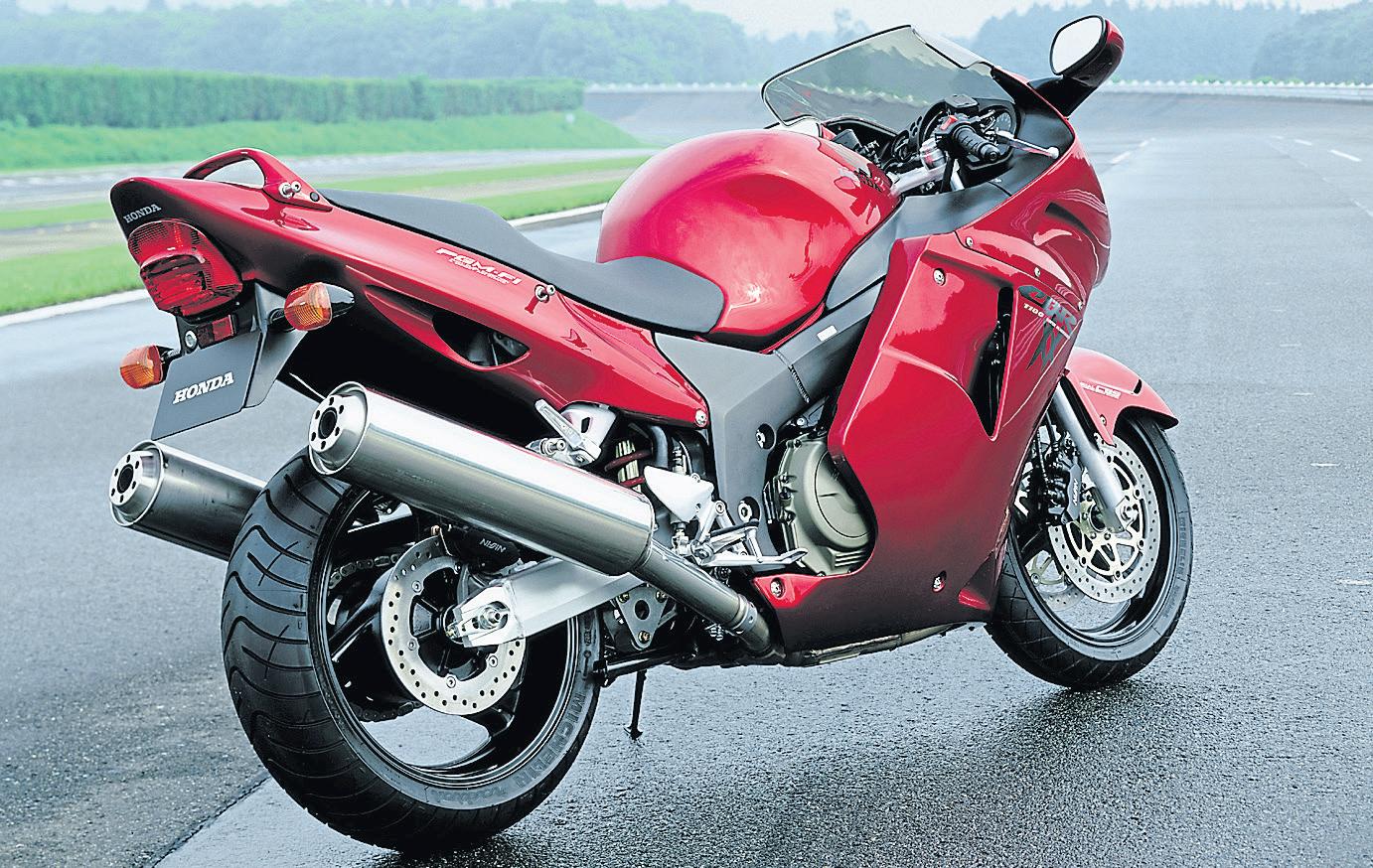

The subsequent VFR750 confirmed The Big Aitch was back in the game proper and corporate pride took over allied to commonsense engineering.
The marketing team was also sharp enough to realise that despite all of the technical benefits of a V four ,a sizeable slice of its customer base still wanted inline fours. The CBR1000 had validated this but, even though it ran for some 10 years, it was too big, too heavy, too cumbersome and underbraked


The Blackbird has links to the groundbreaking Fireblade in so far as weight reduction, load bearing and considered chassis reinforcement, but not at the expense or unnecessary mass The CBR1100 was designed to be physically larger than the ’Blade because it had a different job to do… well, two jobs if we were being blunt here. It had to address all of the outgoing CBR1000’s perceived ills and trounce the Kawasaki ZZR1100 – it did both spectacularly. Power was up 20 or so bhp over the big Z; weight was down by more than 20 kilos; and, crucially, the aerodynamics left the Kawasaki looking like a beached whale. Arguably, the Blackbird also forced Suzuki’s hand when laying down the profile of the Hayabusa; the Honda was genuinely that influential.
In terms of technology the Blackbird was nothing revolutionary and, for once, Honda managed to resist trying to reinvent the wheel. Pretty much everything about the motor and drive train were pre-existing, but Honda honed and refined e thing so the
Over the machine’s lifetime (19972007) the bike evolved rather than changed, with Honda admirably resisting tinkering too much with what was, after all, a s nd desi


was introduced along with revisions to wheels and bearings, brake rotors, clutch and alternator. Other than cosmetic changes, the next revision saw a digital dash fitted for 2001 and revised fuel injection the year after. Later models in some markets subsequently had catalytic converters added where local laws mandated them. From here on changes were minimal other than colour schemes, graphics, etc.
After an 11-year run the Blackbird was dropped from the range and Honda latterly tried to market the VFR1200 as a replacement but few bought into the notion. The CBR1100 was effectively irreplaceable and rumours abound that Honda might still be considering a modern version based around V5 technology. It will probably be hugely impressive, but it’s unlikely to be able to ace the best hyper sports tourer ever built.
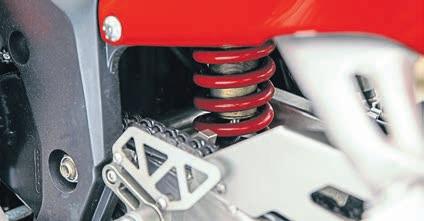
Honda’s Blackbird was built to eclipse Kawasaki and it did admirably, but it also raised the bar for Honda. In fact, Honda never really managed to better the CBR1100 and even its later big bore VFRs have failed to usurp the ’Bird. There’s nothing groundbreaking about the bike, yet it excels at what it was designed for –being stunningly fast, devastatingly efficient and amazingly competent/ comfortable. In essence, it was the pure distilled genius of years of DOHC, four-cylinder, liquid-cooled technology all wrapped up in one motorcycle. It was the fastest bike of the period and was only knocked off its perch by the even more potent Suzuki Hyabusa and then not by much.
If you want to travel far and fast then the Honda CBR1100 Blackbirds are arguably the most cost-effective way to achieve that aim. Refined, hugely competent and with Honda build quality, there’s really not much out there that surpasses both their design brief and ability. Factor in its flagship status and legendary Honda build quality and it’s hard to argue there’s a better bike for the money.
And now for the really good news – Honda CBR1100 Blackbirds are


seriously cheap! A 2000 plate W reg example could be yours for less than £3000! Yes, just three big ones. If you wanted a cheap large capacity machine, a 1998 S plate on high mileage will only take £1300 out of your wallet! A year later and with less miles shouldn’t be more than £2500.
Newer examples tend to sit between £3k and £5k depending very much upon mileage and condition, but you really don’t need to be shelling out much more than £4500 for something very tidy and lowish miles.
Buying on condition and, ideally, with a service record will see miles and smiles in equal proportions.
If it’s properly serviced it’s capable of some serious mileages.
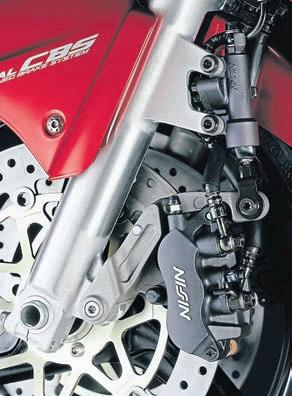
Later models run fuel injection and the FI light is supposed to light up when the bike is switched on then go out. Some rogues
remove the bulb from faulty ones so as not to draw attention to a fault.
Earlier models rub carbs and any rough running is likely to be down to stale fuel gumming things up. Factor in a carb service or negotiate accordingly.

Linked brakes work well but it’s a
Even now the Blackbird hasn’t reached classic status… yet. The first-year Hayabusa is serious money now and the early ZZR1110s the Honda replaced are going up in value. The Honda aces the Kawasaki with less weight and more oomph, and doesn’t lose out too much to the Suzuki. Some prefer the carburettored versions for their smoother fuelling, but the later FI versions are also good buys. Regardless of model and age, a CBR1100 Blackbird will always impress.
complicated system. Avoid examples that have been meddled with.
Yet again the old Honda bogey of regulator/rectifier raises its head – most owners go for a quality aftermarket replacement.

Yes, that old chestnut again – some were
done under warranty, some not. Haggle if it’s a rattler but it’s generally not a deal breaker.
Diagnostic plug corrodes and spreads green stuff into the loom, causing issues.
Unless there’re receipts, factor in a refresh to get the best out of the handling.
Learner-legal sportbikes are big business – and while there’s a whole load of choice from some of the biggest names in the game, you’d be remiss not to check out some of the ever-improving, affordable Chinese machines on the market. How about this one? Lexmoto’s LXS 125.

 WORDS: Nicholas Ellis / PHOTOS: Gary Chapman
WORDS: Nicholas Ellis / PHOTOS: Gary Chapman
There’s still a good chunk of the general motorcycle buying public who recoil at the idea of buying a Chinese bike. They’ve been put off by the cheap and cheerful commuters of the past, which have rusted and rotted and proved unreliable. But things have changed in the last 20 years and the quality of machines coming from the country which manufactures a million motorcycles each month is ever-improving. One firm that knows that is Lexmoto.
The Exeter-based importer has built up a solid reputation for its reliable and affordable bikes and scooters, which are supported by a solid dealer network and a plentiful supply of spares. We’ve ridden more than our fair share of them over the past few years and they’ve generally impressed, neatly balancing costeffectiveness with performance and quality of finish. But the latest generation of bikes feels like a real step forward
A prime example of that is Lexmoto’s LXR 125. The sporty learner-legal bike has been a constant bestseller since its release back in the early 2000s, but in the last couple of years Lexmoto has barely been able to bring enough of them into the country to meet demand. Believe it or not, it was actually the most registered sportsbike in the UK throughout 2020. That tells you everything you need to know…
That’s why it should probably come as no surprise that Lexmoto’s looking to build on the success of the LXR, with the addition of another sporty model to its growing range

Introducing the LXS 125.
First things first, there’s no denying it’s a cracking looking little bike. The sharply-styled sportster, with its funky grey and fluorescent yellow colour scheme, underseat exhaust and LED lights drew plenty of glances from admiring teens – and more than one double take from hardened bikers of all shapes and sizes. It might ‘only’ be a 125, but it looks the part. It feels the part, too. Setting into the seat for the first time, the LXS is just as you’d expect – with clip-on bars, high pegs and similar ergonomics to the current crop of sportbikes from some
of the bigger name firms (like Aprilia’s RS125 and Yamaha’s YZF-R125).
Admittedly, I’m 6ft 1in tall and nearly 13 stone so I’d probably argue that this bike isn’t best suited to me and my frame, although I didn’t feel particularly ungainly on it (while in the pictures I don’t look completely disproportionate). That said, the 1313mm wheelbase, 155kg wet weight and 790mm seat height would likely be perfect for younger (and shorter) learners who’ve got a penchant for sportsbikes.
There’s not a huge amount in the way of technology, with a simple LCD dash offering a gear indicator, fuel gauge, odometer and revs – but
then again you wouldn’t really expect much else. This is, after all, a bike that’s been built to a budget and all the unnecessary extras have been stripped away and all the cash spent on the ride. So let’s get to it…
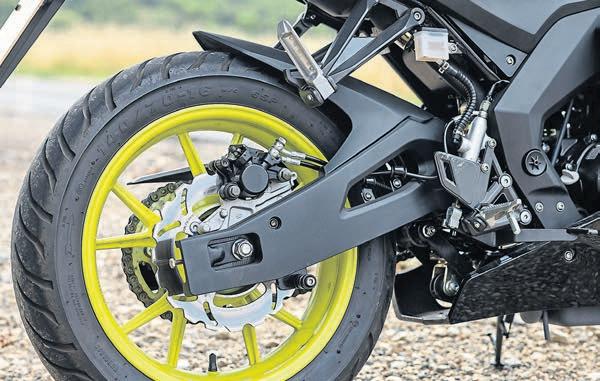
In all honesty it goes pretty well. That’s thanks in part to its beating heart – a 125cc liquid-cooled, fourstroke single engine, which kicks out a respectable 13.8bhp at 8750rpm.


Although torque isn’t officially published, a bit of digging suggests that it’s somewhere around 11Nm.
For a learner-legal ride, that’s about bang on the money. In practice, those figures mean that if you have a bit of room to keep the throttle pinned

you’ll see 70mph on the clocks without too much trouble. Okay, so it’s much happier bombing around between 50mph and 60mph, but there’s enough in the tank to mean that the bike’s able to safely hold its own on faster A-roads (and even dual carriageways). Of course, you’ve got to work it pretty hard to make any kind of swift progress (it’s all about context…) as you rattle through the surprisingly smooth 6-speed gearbox. Stopping is looked after by a set of twin petal discs up front (and a single disc at the rear). Two discs might sound quite serious for a lightweight learner-legal machine, but actually there’s some clever stuff going on

beneath the surface which means you can use them independently. As with many modern 125cc machines (particularly from firms that are keen to keep costs down), the LXS comes kitted out with a Combined Braking System instead of an ABS unit. It works well. Apply pressure to the rear brake and you’ll also engage one of the front discs. Pull the front brake and you’ll engage the other front disc. Simple. There’s plenty of power to pull you up quickly and safely if you need to stop in a hurry, although there’s not a huge amount of feel for gently applying pressure and knocking off a tiny bit of speed
Suspension comes in the form of a set of telescopic forks up front and a monoshock at the rear. It’s basic but capable – and the LXS has plenty of poise under pressure and enough give to soak up big lumps and bumps without bouncing you out of the seat. That’s about all you could ask for, I think.

There’s plenty of grip from the tubeless 16-inch Cheng Shin branded rubber. I’ve never heard of the firm before but I was pleasantly surprised by how comfortable I felt on the bike, even in the wet. That said, I am sure a set of ‘proper’ branded rubber would have the ability to improve the bike’s handling. If it were my bike, that’s the only change I’d make.
If you’re in the market for a CBTfriendly sportsbike that looks the part, then the Lexmoto LXS 125 is surely well worth a closer look. Priced at £3099 (plus a few hundred quid more to get it on the road), it might be less expensive than the majority of other new bikes of a similar style, but it’s not exactly cheap. You could easily find a fairly tidy two- or three-yearold secondhand ride from a ‘more established’ brand for similar money – but then again, you won’t have the additional peace of mind of two years parts and labour warranty, coupled with an extensive dealer network which has consistently won awards for its customer service.
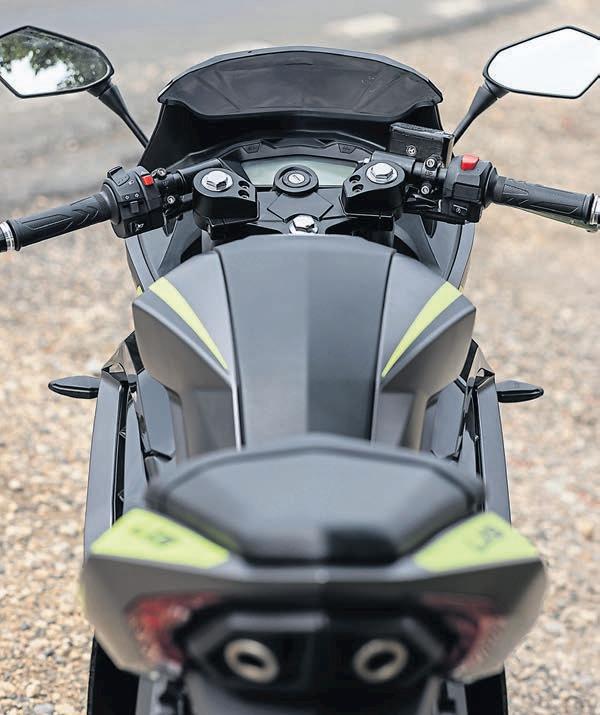
Whatever your preference, there’s no doubt Lexmoto’s going to sell plenty of these funky little sportsters.

Engine:

“It’s much happier bombing around between 50mph and 60mph – but there’s enough in the tank to mean that the bike’s able to safely hold its own on faster A-roads.”
From its 14-litre fuel tank the Terrain’s capable of returning up to 200 miles of ‘hard’ road riding from a single fuel stop. If you were more restrained with the throttle, we’re confident you’d be able to eek a few more miles from the tank.


Suspension comes in the form of telescopic USD forks at the front and a monoshock at the rear (which has preload adjustment – a nice touch). They’re more than up to the job and offer a great balance between comfort and performance, though it’s all set up fairly soft to help deal with the worst that the roads and dirt can throw at it.
The T125 might not be the most accomplished off-road machine you’ve ever seen, with its fairly low ground clearance, road-oriented rubber and 17inch cast wheels slightly limiting its ability, but it’s low enough and lightweight enough to inspire confidence and encourage you to take it places you’d never dream of taking a bigger (arguably more capable) adventure bike.
What really sets it apart from other adventure motorcycles on the market, despite its big-bike appearance, is its relatively low size and weight. Firstly, it weighs in at just 162kg, which helps to make it easy to manoeuvre on the open road, paddle round car parks, and even pick it up (when you inevitably drop it) off-road. Its seat stands at 780mm, too, so the Terrain should be within the bounds of most riders.

The little Terrain is powered by a 125cc single-cylinder air-cooled engine which kicks out just 12.7bhp, so it’s not going to be setting any records for speed. However, it’s plenty nippy enough off the mark with 10.5Nm of torque to play with.
From a braking perspective, the Terrain is equipped with linked hydraulic disc brakes. Although a little strange to get used to for more experienced riders, they offer ample stopping power and are super-easy to use for bikers who are doing their first miles on two wheels.
When most motorcyclists think of adventure bikes, they’ll picture a big hulking GS or Africa Twin. But over the last few years some of the biggest players in the motorcycle game have scaled down their adventure bikes, making them more accessible and affordable. However, learner riders have been left out in the dark by the top brands. Thankfully, Sinnis has got them covered with its ruggedly handsome Terrain 125.
Looking at the Sinnis Terrain in the flesh you’d easily be forgiven for thinking there’s more than a 125cc on offer, with its big-bike styling disguising its limited, learner-friendly power output. It’s equipped with all the typical adventure-style addons as well, including crash bars, a taller screen, full luggage set, a USB charging port, a bash plate, and it’s even got an adventure beak on it. Cool, right?

For the uninitiated, Sinnis Motorcycles has been selling bikes built by Chinese manufacturer Jinan Qingqi (who makes parts for the likes of Suzuki and Peugeot, in addition to producing smallcapacity motorcycles) in the UK since 2006.

Welcome to Watt Bike. The electric market’s getting bigger and bigger – that’s why we’ve introduced this standalone section that’s dedicated to all things electric. We’ll be bringing you news, products, guidance, tips, tricks and, most importantly, reviews of the latest and greatest electric bikes, scooters and pedalecs to come to market every single month.

The American factory has just revealed a new adventure bike as part of its growing range of electric bikes.
While we might have seen our fair share of commuter scooters and plenty of crazy concepts, actually, there’s been very few practical, realistic, ‘proper’ electric motorbikes to get all that excited about of late. Harley-Davidson has had a good crack with its newlyformed Livewire brand; Energica is doing some cool things, too, including a new sharp touring bike; and, of course, there’s Zero. The American firm has made a name for itself for building proper bikes for bikers – but now it’s decided to take on one of the mostly hotly contested categories in biking. The adventure bike market.
Okay, so while the DSR/X may be brand-new and is Zero’s first proper foray into the adventure category, that doesn’t mean it hasn’t come close before, with dirt-oriented
and touring-style models both available at some point in its short but illustrious history. That said, the DSR/X is a step up. It relies heavily on Zero’s naked SR/F and sporty SR/S models, but gets some ‘proper’ 19-inch front and 17-inch rear wheels.
Getting into specifics, it comes kitted out with a 17.3kWh battery, and the same Zephyr 3+ operating system as the SR models. That said, there’re plenty of key differences to help it
stand out. For starters. the motor has a new casing and different winding configuration. It has effectively been retuned for 20% more torque, bringing the peak torque figure up to an eyewatering 225Nm. However, this has come at the cost of maximum power, which is down to 100hp (75kW).
The steel trellis frame may look familiar, too, but it’s been strengthened for adventure duties. The swingarm’s had a similar treatment, and although it’s actually the same design, features a different construction. The drive belt is also wider than before and the rear ‘sprocket’ for the belt is perforated to avoid stones getting stuck there.
There’re five main riding modes to choose from, which all have their own throttle map, power output, traction and ABS settings. And there’s also an off-road option for each one of them, which means there’s actually a massive

(and probably a bit excessive) 10 modes to play with. There’s also plenty of technology working in the background to keep you safe, too, including the traction and braking performance being guided by the six-axis IMU from Bosch. Brakes are also linked, which is novel on a big bike but essentially means that when using the front lever you’ll apply a bit of rear, too. The bike has hill hold and cruise control, and heated grips are standard fitment.
It does sound like Zero’s right on the money with the kind of bike it’s building, and if past performance is anything to go by, it’ll likely do very well. At £24,150 it’s certainly not the most expensive adventure machine on the market, either. We’ve got a launch report coming in an issue very soon, so keep your eyes peeled if you want to find out even more about the latest machine from the growing California firm.
Okay, let’s knock some electric motorcycle misconceptions on the head before we go into how absolutely fantastic the latest EM trials bike is. If one was to believe the eco-lobby then electric vehicles, be they two, three, four or more wheeled, are the latest thing, invented last week by seriousminded people wearing Jesus sandals and existing on a diet of lentils. The reality ignored by such people is they didn’t invent it and electric vehicles have been around a long time. It didn’t even take much looking in the Classic Dirt Bike magazine archive at Mortons HQ to find references of working electric motorcycles in 1919, yes 103 years ago
With a feature on them in the press of 1919 it suggests they were in development much earlier so, what was the problem? Same as these days really, the infrastructure for petrol motorcycles was already in place and petrol was being produced well before there was a need for the substance as a fuel. A by-product of lamp oil production it was simply thrown away until someone thought, ‘Hang on, we’ve gallons of this stuff, can’t we sell it?’ So, petrol power, dead easy – the poisonous fumes from the process of pouring the stuff in your tank to the smoke coming out of the exhaust pipe was less of a problem when there was one petrol-using
vehicle per 10,000 square miles than it is today when it seems there are 10,000 vehicles per square mile creating actual life-threatening pollution.
Now, pollution comes in many forms and the noise our bikes make may be music to our ears but not everyone is as keen on the sound as we are, so it’s not just the fumes coming out the back which cause us to be frowned upon by the general public. In the world of off-road motorcycle sport such as trials this

double whammy is a real concern and puts many courses in peril of being lost, with complaints of noise and smell being aimed at riders and event organisers. This is where electric bikes score points. The public perception of petrol bikes is noisy, smelly things ridden by louts, while electric bikes are seen as eco and friendly and only one very tiny step away from the electric-assisted bicycles which seem to be very popular these days. This perception issue was brought home to me when chatting to a fellow rider on the EM UK test

day, a chat possible because there was no noise from our electric bikes. A long-time rider, he told me of a favourite practice spot he uses...
“When I’m there with my petrol bike you can almost feel the waves of disapproval if not hostility from people out walking yet the same people will engage in conversation when I’m riding my EM…”
Now then, as we established electric bikes are nothing new, nor are electric trials bikes a new thing either. Perhaps some readers will be old enough to recall the indoor trials exhibitions at the Earls Court Motorcycle Shows in the Seventies and earlier. Effectively, this was a novelty to provide a bit of entertainment at the show and the bikes were constructed around a massive wagon battery with a starter motor wired in to provide the drive. The course was 30 or 40 yards long and the queues to try the bikes were much longer. No one at the time thought they would be anything other than a novelty or be any good in a real event. Well, time moves on, development happens if there’s a need for development, and the EM electric trials bikes are a world away from those show demo bikes of 50 years ago; we’re talking serious contenders for trials success here.
My introduction to the electric bike world came a few years ago at the International Dirt Bike Show when it was at Stoneleigh. We’d a trials demo area and EM asked if it could run one of its bikes on it for a potential customer. We also got a go and were pretty impressed with it, though there were some reservations over the bike not having a clutch. It seems such concerns were noted and the latest EMs have a clutch and, in fact, ride pretty much as a petrol bike would except there’s no noise or gasses which is a great boon in the queue to tackle a section.
Having tried the earlier model I was looking forward to seeing what the latest incarnation was like and try some of the innovations which were introduced for the team bikes in the SSDT. The model I was riding on the day was the EM Epure Race, and there are three power settings on
the motor which are best likened to capacity classes on a petrol bike. These allow the bike to be dialled in to the rider’s needs or level of expertise. For me the base-line setting was perfectly adequate for everything tackled on the day and is effectively the 125cc setting.
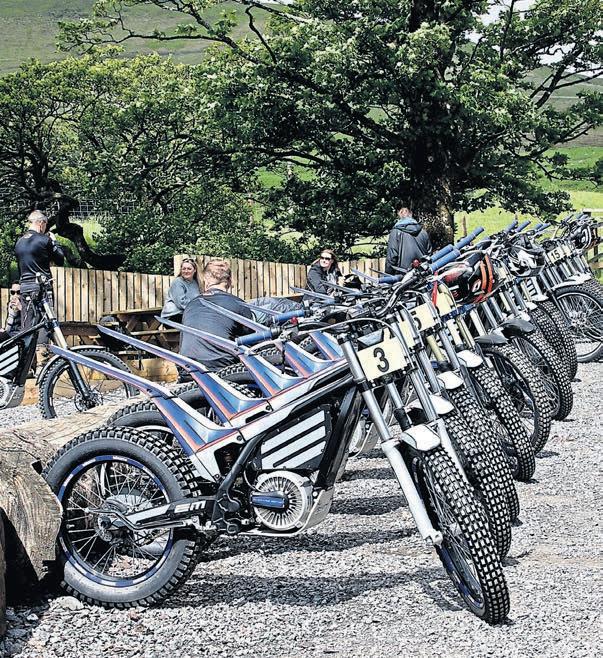
Built around an electric motor with a 6kw rating though peak power is 11kw, means when you snap the twist grip open there’s the oomph to propel you and the bike up a massive rock step. The frame which houses this motor and the battery is conventional enough with its welded perimeter design and open cradle connected by a stout bash plate.
On the 2022 model rear suspension is handled by an R16V Factory threeway damper, while up the front end are a set of aluminium TECH forks so, with wheels of standard trials sizes and wearing Michelin tyres and superb disc brakes, the cycle spec is as good as it gets. Actually, the brakes were the only issue I had with this bike… they worked… and I’m not used to such good brakes as most of the classics I normally use don’t have such good stoppers. So it took a while and one ‘off’ to realise I didn’t have to grab on the brake lever with all my might and really two fingers on it were enough. Though there was no need to use the clutch when waiting at a section, as once the throttle is
closed the bike just stops especially if tickover mode is selected, I found nearly 50 years of riding conventional trials bikes was difficult to overcome and the habit of blipping the throttle before setting off through the begins cards was hard to ignore. Do this on an electric bike without holding the clutch in will make you unpopular with the rider in front of you in the queue. Riders new to the sport or new to motorcycling won’t have these ingrained habits and are likely to have little problems with this aspect of the bikes. On the move, of course, there are no gears to worry about so instantly one topic of in-section discussion – ‘What gear are you going in?’ – is removed.
It is fair to say in 48 years of competing in motorcycle sport –mainly trials but including enduro and the odd scramble and hill climb, too – no trophy engraver has become rich on Tim Britton. I’ve never claimed to be more than a decent club rider and can honestly say I’ve ridden with the best in the best, they just finished further up the results list than me… a lot further up. Since starting in motorcycle sport in 1974 I’ve ridden the SSDT, tackled British Championship One-Day trials, tried sidecar sport, ridden modern and classic machines, and had a boat-load of fun along the way even if factory team managers have, so far, not tried to out-bid each other for my services.

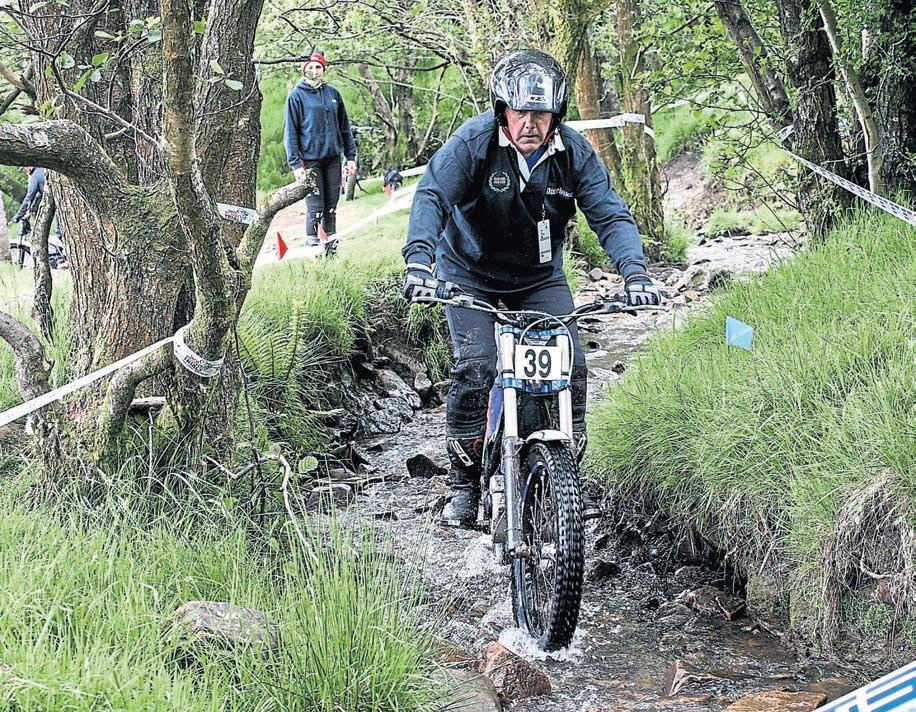


Based at Hey Barns near Clitheroe, EM UK is making a big impact on the electric bike scene, but not just in the UK. EM – Electric Motion – is a French company. Its UK distributor is Nigel Scott. A lad no stranger to traditional motorcycle sport, Nigel is more than a dab hand at trials but has been a top rider in MX, supermoto, road racing and sidecar trials, too. The connection with Electric


At Inch Perfect’s test day the course as laid out included most of the things a club trials rider would meet during the course of a trial, from a rocky gulley to a slippery stream bed and all the twists and turns, drops and climbs associated with this sport The Epure Race managed everything with no dramas and was confidence-inspiring in the trickiest of conditions as there was no popping or spluttering from the motor, just smooth power all the way
After the trial I had a brief chance to catch up with Matthew Alpe and Nigel Scott to ask a few questions which always arise when people discuss electric bikes – battery life being the biggest one. Nigel said: “For the Scottish Six Days there’s enough battery power to easily go between the fuel stops so in this respect we’re the same as the petrol
Motion came because it fitted in with his business and the bikes were right, as well as the company behind them being focused on making sure they stayed ‘right’. Such is Nigel’s belief in the bikes, he encouraged a team to tackle the Scottish Six Days Trial this year – 2022 – and the bikes proved their worth there. Check out EM UK on www.electric-motion.co.uk or see them on Facebook.

bikes and we had a fresh battery at each checkpoint.
“There were some grumbles about us changing parts as we clipped batteries on and off but all we were doing was refuelling the same as the petrol bikes as no one expects a tank of petrol to last the 700 miles or so the Scottish is.” He went on to explain if anyone wanted to do the Scottish on an EM then spare batteries could be leased for the week. On the subject of battery life
there are ways to increase it and there is a PRB ‘R’ lever on the race model.
What this does is act as an engine brake and a progressive regenerative brake… sounds fancy, and I got this from the brochure.
For those of my generation this lever acts as a decompressor would while descending a steep drop, except the decompressor never added fuel to your tank whereas this little gizmo adds some charge to the battery.

All in all the EM Epure Race trials bike is an excellent machine which may play a major role in bringing trials into a new era. There are few maintenance issues with it; lube the chain, check the tyres and all is well. Chatting to other riders at the finish, the only problem anyone had had was the ignition cut-out
on a lanyard failed… this is the same one fitted to all new trials bikes and as such could have happened to any make. It seems a phone call to EM UK had one out the next day so clearly the back-up is there, too. If you’re interested in this electric thing or indeed just want to try trials then either go to the Electric Motion UK website or Inch Perfect’s website and book a day.
From a one-off event at a local agricultural show to display the sport of trials to a wider audience, Matthew Alpe’s Inch Perfect Trials Display has grown exponentially to become a ‘must-have’ part of not just motorcycle shows, but events as diverse as supercar and flower shows. The interest from such displays has generated a demand for experience and training days for all sorts of riders, be they total novices wanting to try or more experienced riders wanting to improve. Now, with around 100 acres of trials land available to use, Inch Perfect has the ideal area to introduce anyone to the sport and a team of professional riders taking care of riders of all ages seven and over whatever their ability level.
The latest addition to Inch Perfect is its state-ofthe-art showroom packed with bikes, accessories and all sorts of trialsrelated gear, so if you decide the sport is for you then it can kit you out.
The training and experience days are available seven day a week so there will be a day for you. Check them out at www.inchperfecttrials. co.uk
The MB legal column is compiled by managing partner Andrew ‘Chef’ Prendergast and his bike-riding barristers and solicitors at White Dalton Motorcycle Solicitors. The firm deals with personal injury claims and its sister company, Motor Defence Solicitors, deals with all the motoring offences. White Dalton lawyers have a vast knowledge of bike law, and they have full bike licences, too. They don’t act for insurance companies or the prosecution. White Dalton is Britain’s premier specialist motorcycle law practice, and if its professionals don’t know the answer to your question, there probably isn’t one. Don’t rely on the advice from your insuranceappointed solicitor, get proper independent advice. For road traffic offences, call the Motor Defence solicitors on 0800 280 0912. For non-offence cases, call White Dalton motorcycle solicitors on 0800 783 6191.
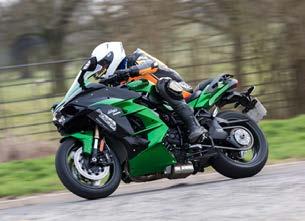









It was the summer of all summers and my neighbour’s kids were understandably out in the garden 24/7 bouncing on their trampoline or jumping in their paddling pool. I had no issue with that, why would I? However, now the weather has changed, the wind has picked up, and I’m ‘hopping mad’ (pun intended) because whilst getting my Kawasaki Ninja H2 SX out of the shed to go to work, the idiots videoed the trampoline and messaged me it!!! They thought it was hilarious. For about 10 minutes they filmed the trampoline from their bedroom lifting and flying around their garden. Unfortunately, it then flew about 20 feet in the air before crashing over the fence on top of me and the bike. Thankfully I was okay, but the bike’s fairing and screen took a right kicking. I’ve been to speak to my neighbour about getting it fixed but he just said was an ‘act of God’ and I should claim off my fully comprehensive insurance policy or fix it myself whilst still laughing about the video. I was seething and am just working out whether I can actually claim off him or not (I may just suck it up to keep the peace). What do you reckon?
A

My view is you could claim off your neighbour, if you want to. Legally, if he owns the trampoline, he should have secured it properly in case it was windy. (I bet if you found out the make and model, the instructions will have warned the user about this.)
In any event, as he has not secured it and then watched it get blown around whilst his kids videod it, he is a ‘class A ballbag’ and a Judge will find him negligent in my opinion. Whatever you do, make sure you save a copy of the video as evidence in case you do want to claim off him. As for ‘keeping the peace’ I do get it, so you need to have a think. However, I would add that if you do not want him to pay for the damage personally, you could ask him if he has house insurance as they may well pay out for your claim. I hope you ‘bounce back’ from this (I apologise unreservedly for the bad pun).

QAround two years, ago I was just minding my own business trundling along the high street on my Yamaha XJ600. I had just gone over a pedestrian crossing after letting a little old man walk over it. Just after that, I indicated and then began to turn right into a side road as I needed to go to the post office. It was at that point when a lunatic
If you need advice on a biking-related legal question or query, email mail@whitedalton.co.uk. The best Q&A will be published in MB, in confidence, of course.



delivery company driver decided to overtake the HGV behind me, on a pedestrian crossing, and also try and overtake me. It would be fair to say the only thing he delivered that day was a broken right leg to me, and a trashed bike. If I could have got up, I would have punched him. However, I couldn’t and laid there on the floor like a sad sack of potatoes The old bill rocked up and, armed with the dashcam from the HGV, the delivery driver got done for dangerous driving and banned. Therefore, as far as my case was concerned, I thought it would be easy. However, the delivery driver and his insurer were idiots so after a year my solicitor issued Court proceedings against both of them, and we should be heading to Trial next soon, I hope. The fear I have now got is my solicitor has told me the delivery driver’s insurer has gone bankrupt. Does this mean I will not get paid? The insurer is Gefion.

AIt’s not clear if you are going to Trial to deal with who is to blame for the accident, or only to decide how much your claim is for. However, on the blame front, I would be highly surprised if you did not win this 100% on liability. The delivery driver sounds like a right dipstick. Therefore, the following advice is on the basis the Trial is needed for the Judge to hear the evidence and then make an Order as to how much you get. As for actually getting the money after the judgment, you could seek it directly
from the van driver, or his insurer, Gefion. The advantage of getting it directly from the van driver is you do not have to deal with the bankrupt insurer (read on) and you can leave it to the van driver to get the money back from his insurer, who is now bankrupt. After all, he paid a premium to cover this risk. However, whilst you could do that, practically, I suspect the van driver may not have several thousand pounds to pay the judgment against him. Therefore, if you were my Client, I would get the judgment for you (on the basis you win your claim) and then direct the claim to the Financial Services Compensation Scheme (FSCS) in the event the van driver/Gefion do not have solicitors representing them. The FSCS’s website is very useful and states, ‘Gefion Insurance A/S (“Gefion”), a Denmark-based insurance company entered into insolvency proceedings on June 7, 2021. It is no longer paying claims.’ However, it continues by stating, ‘FSCS declared the firm failed (in default) on June 7, 2021 and is stepping in to protect the majority of policies Gefion sold to individuals and small businesses in the UK.’ In other words, practically insofar as you are concerned, the FSCS will effectively pay out for any judgment that Gefion is liable to pay. Therefore, you will get your money if you win at trial, but it may take some time to get paid afterwards whilst it works its way through the claims system

The 2001 season might have marked the coming to an end of the 500cc era, but it always was going to go out with a bang. Honda’s sullen 2000 was forgotten as the motorcycle giant went for it big time. There were some seven riders on the fearsome NSR500 and another eight on the V twin NSR500V. Not wanting to put all its eggs in one basket Honda spread the risk across some six teams – Repsol Honda, Pons Racing, Shell Advance Honda, Arie Molenaar Racing, Dee
Cee Jeans Racing and Nastro Azzurro Honda. The last team featured Italian riders Lors Capirossi and Valentino Rossi and these two guys, along with fellow countryman Max Biaggi, would go on to dominate the season to all intents and purposes.

The previous year had been Rossi’s rookie season playing with the big boys and he rattled more than a few cages by coming second and one place ahead of the ‘Roman Emperor’ Biaggi… that hadn’t gone down well. Obviously, Max’s ire had been raised and the Yamaha rider went into the opening Suzuka, Japan, round with the notion he was going to put the ‘young cub’ Rossi in his place, which
didn’t work out too well to be honest.
Under what’s politely referred to as a racing incident, Biaggi pushed Rossi off the track and into the dirt at some 150mph – of course Rossi wasn’t having any of it. Two laps later Valentino blasted past Max and extended his middle finger to the Yamaha rider. Rossi took first and to Max’s disgust fellow Yamaha rider Gary McCoy took second to the Roman’s third. Apparently the animosity culminated with a full-on fight in parce ferme at Catalunya away from the cameras!
Rossi’s start was in the ascendant and he took the title with 325 points, leaving Biaggi second on 215 and

teammate Capirossi on 210. Despite Honda’s mass of riders and machines outside of the top three, the next Honda rider was Àlex Crivillé in eighth with just 120 points. However, Honda had won the title via Valentino at only his second attempt and taken the Manufacturers’ Title with 367 points to Yamaha’s 295 – Suzuki could only manage third with 153.
Even as Rossi was stamping his authority on the final 500cc stinkwheels season HRC was back in its happy place with four-strokes developing a machine for the 2002 season. The all-new RC211V would feature a 75-degree V, 990cc motor, with five cylinders delivering in excess


of 210bhp at 14,000rpm. That might sound impressive but it had taken an almost 100% increase in capacity to get a four-stroke to match the power of the old 500cc smokers. And, just in case you were wondering, yes, Rossi spanked Biaggi on the new 990 ‘diesels’ (as some uncharitably referred to them) for the 2002 title as well – 355 points to 215!







We might not always tell you, but you lot are important to us. You’re the reason MoreBikes exists – and you’re the reason we work hard to put together the best newspaper we can every single month, with as much cool content as we can get our hands on. And as you’re the one’s out there reading the paper, we thought it was about time to ask for a bit of feedback to see if we’re getting things right. That’s not all. We want to learn more about you. The more we know, the better we

can tailor the paper’s news, reviews, features, and even advertisements, to suit.



That’s why we’ve created a short survey to get some indepth information about who you are, what you ride, and what you want from your freeto-pick-up biking bible.



And we’re not asking you to give up your time for nothing – we’ve joined forces with Held to offer everyone who takes a minute or two to fill in a survey the chance to win a pair of its Gore-Tex Twin II four-season motorcycle gloves.






■ To fill in the survey, either visit www.morebikes.co.uk and type in survey or scan the QR code with your smartphone and be taken straight there. Simple. It will only take you a few minutes to complete… and you’ll automatically have your name thrown in the hat for the chance to win a brandnew pair of gloves.


Win one of three pairs of Held’s award-winning GoreTex ‘Twin II’ dual-chamber 4-season motorcycle gloves. The dual-chamber means that effectively these are two gloves in one! One chamber offers you perfect grip with X-tra Grip, whilst the other chamber is the ‘warmth’ compartment with Primaloft insulation. Whatever the weather these waterproof, breathable and windproof Gore-Tex motorcycle gloves from Held will keep your hands at the optimum temperature. A fantastic prize – these gloves have an RRP of around £190.




































ARIEL RED HUNTER 350cc, 1954, maroon, all complete, with V5, ideal recommission or restoration, dry stored, £2200. Tel. 01299 266565. Worcs
BMW R1200RS Sport SE, 2018, every extra, ready to tour, full BMW service history, standard seat & Heli bar risers, full 3 piece luggage, inc top box rack, BMW engine bars, Leo Vinci can & original Chrome pipe, BMW sat nav and relocation, Fenda Extenda, mud sling & BMW wide mudguard, bike has a current MoT, £8200 Tel. 07759 715595.

DUCATI HYPERMOTARD 821 2013, beautiful bike in superb condition with no marks or scratches, only 4200 miles, recent full service with new battery and rear tyre, whole years MoT, runs perfectly, always well maintained and only ridden in the dry, must sell so priced accordingly, £5950 Email. john.botley@gmail.com
HONDA SHADOW 600cc, 1998, years MoT, V2 custom, 9800 miles, Cruiser, very good condition, £3000. Kawasaki 550 Zepher, new exhaust, private plate, painted Z1 colours, 28,000 miles, 1992, £2000 Tel. 07395 910839. Norfolk
KAWASAKI ZRX1200R 2002, green & white, Akrapovic & K&N, fork brace, Hagon rear suspension, good tyres, owned for 8 years in my name, two keys, datataged, 23,000 miles, full MoT, £5950 Tel. 07508 346500.
TRIUMPH AMERICA 2005, 10,300 miles, good condition, many upgrades, OEM spares, too heavy now, £3600 ono Tel. 07823693477.Nottinghamshire.
KAWASAKI GPX750 1990, 21,500 miles, years MoT, new tyres, battery, carburettor jets, new calliper seals, fork oil seals, rides well, smokes on start up but clears quickly, can deliver within 30 miles for cost, £1350 Tel. 07974 095654.
KAWASAKI ZX900 2000, project bike, very much complete purchased recommission back to roaduse,£750.Tel.07950398750.


KYMCO XCITING 2021 (71) reg 400cc, maxi scooter in blue, genuine 4900 miles, fsh, showroom condition, no winter use, garaged warranty to November 2023, £4699 ono Tel. 07784 499299. South Yorkshire.
TRIUMPH TIGER CUB 1963, rebuilt, just over 1100 on clock; Honda XL70, 1973, been in Stafford Bike Show, rare little bike, 4400 miles, price for both £5850 Tel. 01253 736245.
YAMAHA XJ6S Diversion, 2009, 31,600 miles, 7 months MoT, power bronze high screen, heated grips, Scottoiler chain oiler system, pyramid hugger, topbox, all round good condition, always, garaged, £2300 ono Tel 07714 378253. West Mids.

HARLEY-DAVIDSON new parts:
pair of new brake discs, rear PFM
HD002-4807, pair £70. Zodiac front HDF 235473 Avon Venom rear tyres 150-80-16 like new, £30. Chrome belt guard, £20.
SUZUKI GSF600 Bandit, 1997 new parts: foot pegs pair, £12. New clutch switch, £2.50. New rear brake pads, £8. Gear lever, £20.HendlerHandlebars3/4,new £30. Harley disc rear PFM HD0024807 pair, £70. Zodiac front HDF 235473, Avon Venom tyre 15080-16 like new, £30. Honda CX/ CL 500 + 650 Haynes manual, £7. Can send pictures Tel. 07704 343331. Stockport
TRIUMPH SPEEDMASTER rear section silencers, mint, removed from 1000 mile bike, original factory spec with brackets, £400 collection only. Also Thunderbird 900 chrome headlight bucket, recently rechromed, mint, £90, £5 postageTel.07434513161.Lancs.
TRIUMPH THUNDERBIRD rear section silencers, new in original boxandpackagingfitsLegend,also ideal concours or museum rebuild 900cc, collection only, £1800 headlamp bucket, chrome mint £90Tel.07434513161.Lancs.
WANTED SMALL VAN 7.510cwt for odd jobs around the house, garden, rubbish etc, age not really important as long as MoT plus towbar if possible, contact with details Tel. 07790 512582. Shropshire.
LEATHER MOTORCYCLE JACKET, Rocker era, 1960s, any condition, good price paid. Waxed cotton jacket or coat, similar age also wanted. Tel. 01223 350289 evenings.
Cambridge
ABBA BIKE STAND with fixing kits for Kawasaki ZXR750 and ZX-6R Ninja, fixing kits for other bikes available from ABBA, little used, £60 Tel. 01516 069983. Wirral.
BSA C11G 4 speed, 1955, full engine rebuild, new clutch, original good condition, free tax, MoT not required, sounds superb, reliable, starts easy, excellent runner, £3100 ono Tel. 07833 906774. Oxfordshire.
FANTIC K-R00 1990? 250cc, good condition, trials bike, blue, white in colour, £1120. Tel. 01225 743415. Wilts.
HONDA CBR600FY 2001, 32,000 miles, red and black, recent new tyres, c/sprockets, battery, new MoT, tidy reliable bike, motorcycle tech owned, bargain, two keys, all paperwork, service history, £1595. Tel. 07748 942271. West Yorkshire.
HONDA SH300I 2012, 1800 miles, two owners, MoT until November 2022, ABS, heated grips, new battery, front pads, front fork seals, rear shocks, drive belt and rollers replaced, some superficial body panel damage, top box included, good condition, £2200 ovno Tel. 07976 218061.
HONDA SHADOW VT750 in good working condition, will put 12 months MoT on for buyer, stainless steel spokes fitted, chrome radiator guard, riding boards & rack installed, original pegs and rear seat still with bike, new battery, this is a second bike & surplus to requirements, £3500 Tel. 07739 412143.
KAWASAKI GT750 P7, 1992, 34,000 miles, restored 4 years ago including full respray, new exhaust, all bearings brakes etc rebuilt with new lines, over £1000 spent on parts with all invoices and a list of works carried out to date, condition is very good, but does have the odd mark here and there, good tyres, fork seals replaced last year, MoT till end of March 2023, £2995 Tel. 07359 100681.

KAWASAKI ER5 2005, front forks serviced, new tyres front and back, new voltage control regulator chrome engine bars, rear carrier, front side lights on a bar, head gasket blown, £600. Tel. 07393 779702. Kent.
SUZUKI VAN VAN probably one of the cleanest around, 1880 miles from new, rare 200cc model was only brought nto the UK for 2 years, ideal runabout or future classic, service history + books, £3950 Tel. 07946 484209.
TRIUMPH TRIDENT 660 year 2021, as new, still under warranty, full dealer service history, heated grips, bar end mirrors, immaculate, £6400 Tel. 07850 408155
SUZUKI BURGMAN AN 400X, 1999, 17,000 miles, MoT, decent condition, tinted Givi screen, new high performant battery, Motabatt, £1150. Tel. 01253 825655. Lancashire. TRIUMPH TRIDENT 2021, as new, still under warranty full dealer service history, heated grips, bar end mirrors, immaculate, £6400. Tel. 07850 408155. North Yorkshire YAMAHA FAZER 600 2000 W, 20,691 miles, dry stored since 2010, oil changed every 1000 miles, datatag new chain + sprockets, SS rad cover, Goodridge hoses, tool roll, Haynes Manual, plus many extras sold seperately for same model, £2400 ono Tel. 07759 790815. Tyne & Wear.
Hendlerhandlebars3/4new,£30. Honda CX/GL 500 + 560 Haynes Manual, £7. Can send pics Tel. 07704 343331. Stockport.
HONDA MONKEY 2022 seat, excellent condition, as new since March 2022, changed because too wide for rider, seat colour black, white, Honda letters and piping, £60. Tel. 07484 675259. West Midlands. Email. george.a.horne@gmail.com
HONDA REBEL 2022, Puig screen, new boxed, cost, £100 accept £70 plus p&p Tel. 01539 725198. Cumbria. Email. roger. harris1@sky.com

HONDA VFR800 F1 model Givi Monokey system wing rack 2, two side panniers, two keys, full instructions, £135. Tel. 07816 150149. Carmarthenshire

KAWASAKI ZZR600D 1990-93 full body plastics and fuel tank, stainless 4 into 2 and aluminium silencers plus link pipes, 2 front discs, £175 the lot. Also standard exhaust for a FZ1 with exhaust valve and cable, £70 ono Tel 07758 515696. Lincs.
TRIUMPH THUNDERBIRD 900 chrome sprocket cover, new in original box and packaging, fits 1995 onwards. Also fits Legend and Sport, £375, £7 postage. Also rechromed cover, mint, £225, £7 postage Tel. 07434 513161. Lancashire.
UNUSED STARTER relay/solenoid to suit Honda CX500, £15. Tel. 07717 742550.
YAMAHA MT09 2013, original seat for sale, good condition, £50 Tel. 07597 754016. Lancs.
YAMAHA TRACER 700 2080 Nitron rear shock upgrade, 100 milesonly,cost,£500accept£250 Tel. 01539 725198. Cumbria. Email. roger.harris1@sky.com
CLASSIC MOTORCYCLE wanted will consider anything, British or Jap, any condition, good price paid Tel.07398052043.Cheshire.

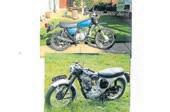



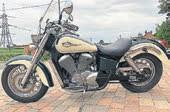
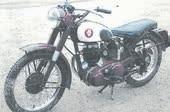
CLASSIC MOTORCYCLE wanted any make or age from a box of bits to a mint machine British or Jap decent price paid Tel. Colin 01514 470147.
ARIEL STORY, Hartley. Takin’ the Mick and Road Racing, both Mick Grant. Save the Triumph Bonneville, Redmond. The Racing Motor Cycle, Woolett TT to Tokyo, Tommy Robb, £10 each plus p&p Tel. 07778 742954. Staffs.
Jacket in green and white to match bike, with Kawasaki ‘K’ on shoulders, size 42, not scuffed or been down shoulder and elbow armouring, £90 Tel. 01516 069983. Wirral.
LADIES MOTORCYCLE JACKET size 16, like new, £70. Magnetic tank bag, £20. AGV helmet, white/pink K-4 EVO, small, like new, £60 Tel. 01656 741428. South Wales. Email. terry. leyshon58@gmail.com
1960’s, maroon, 16” wheels, 3 speed Sturmey Archer gears, all complete rideable or refurbished, £85 Tel. 01299 266565. Worcs. MOTORCYCLE GEAR for sale: boots size 10; Tex Speed, 2 piece suit XL with armour; Richa waterproof coat XL, never worn. Gloves, large, soft pannier rear carrier for Honda VFR1200 with fixings, all good condition, pricing from £5 Tel. 07742 103066. Gloucestershire.























































